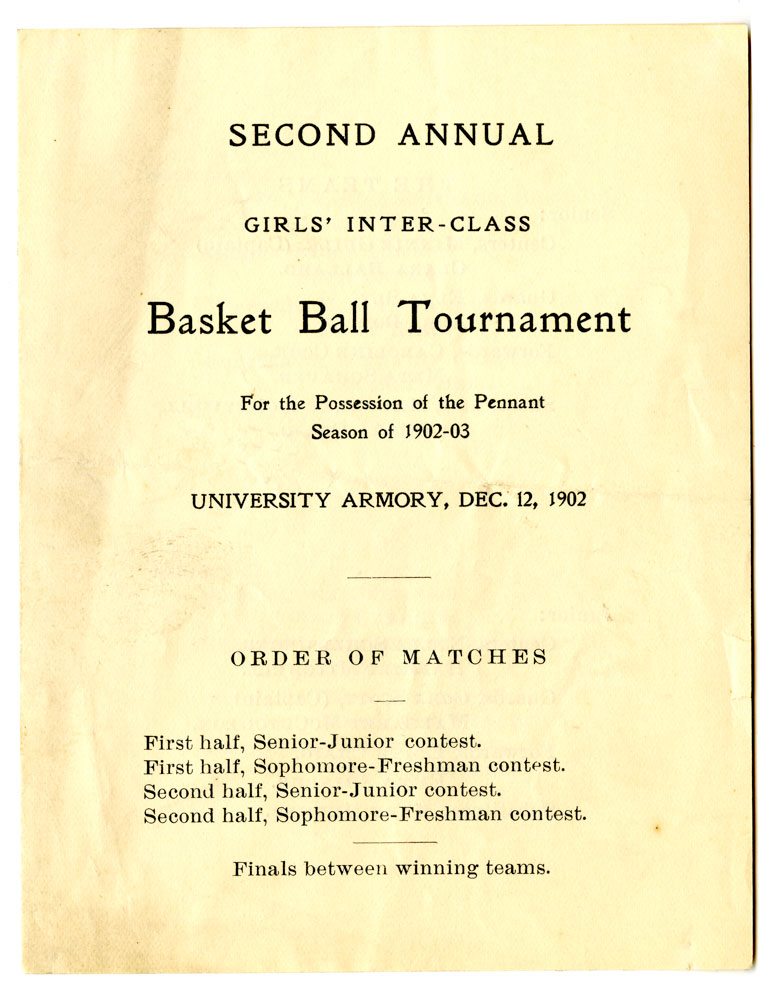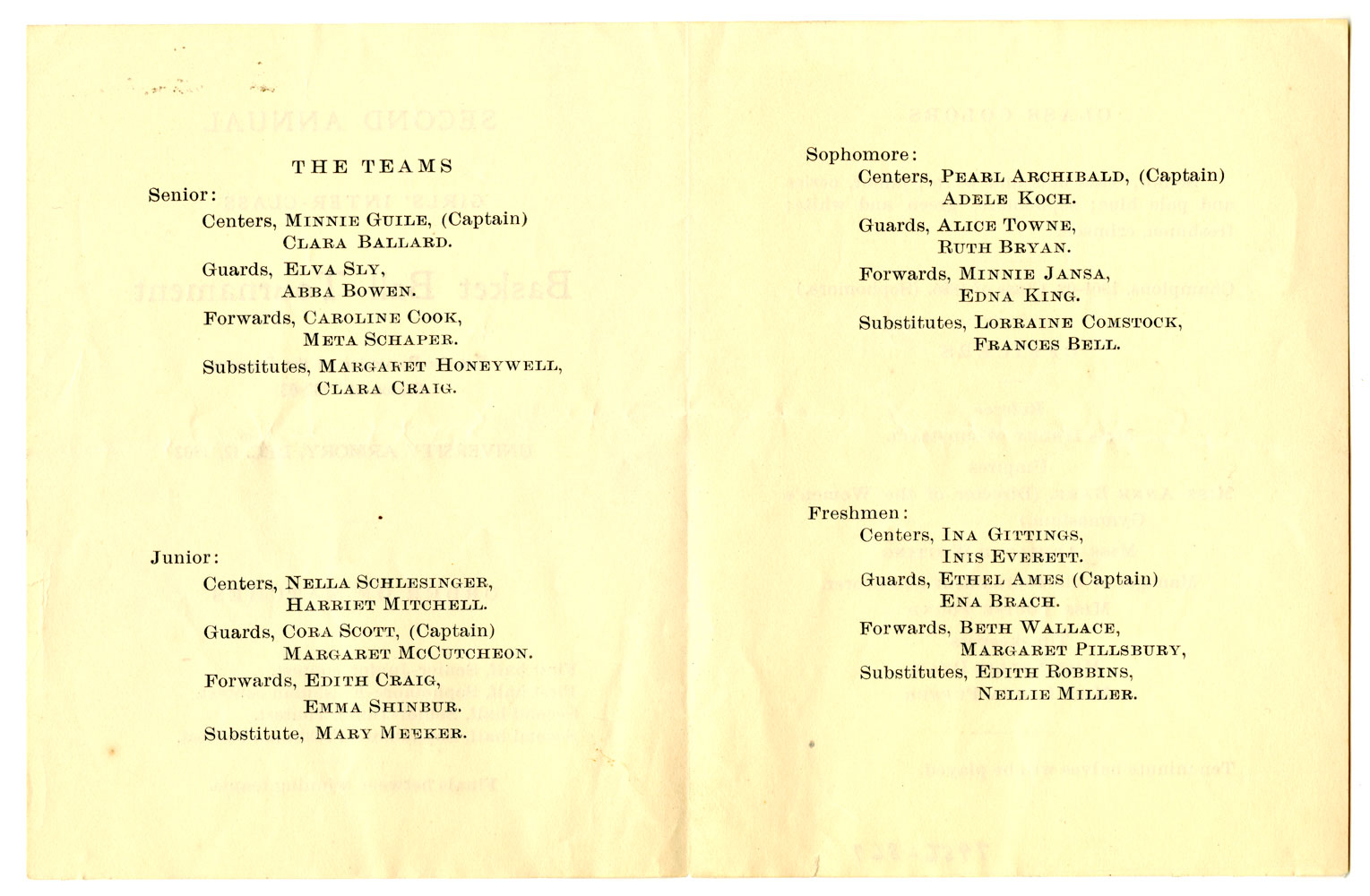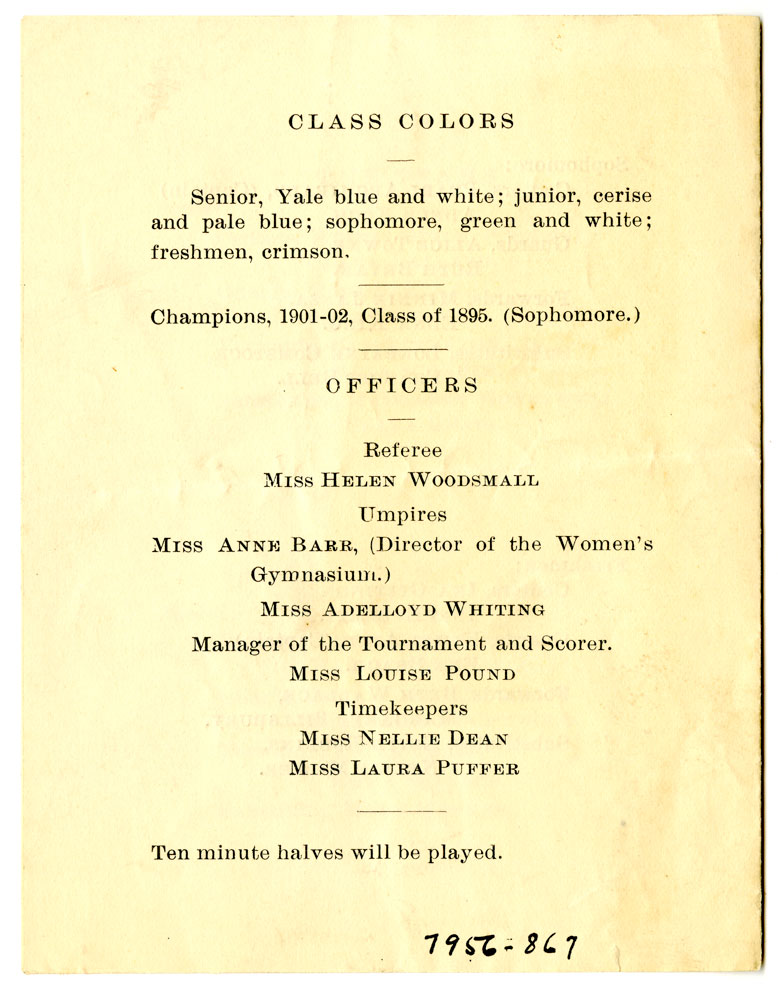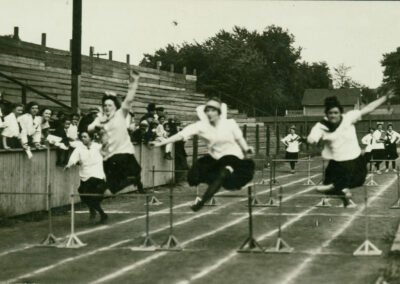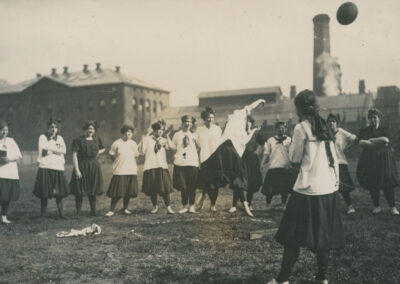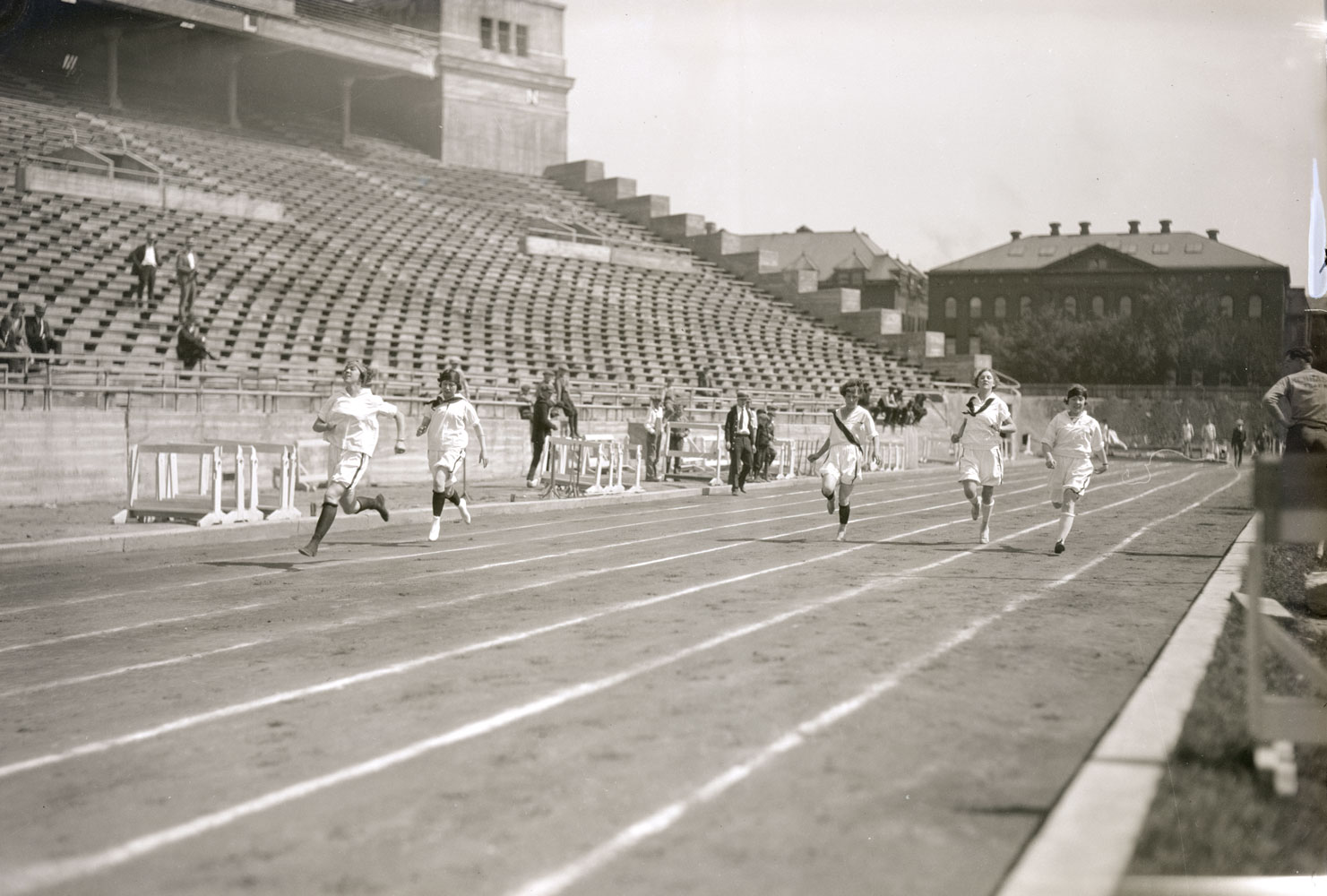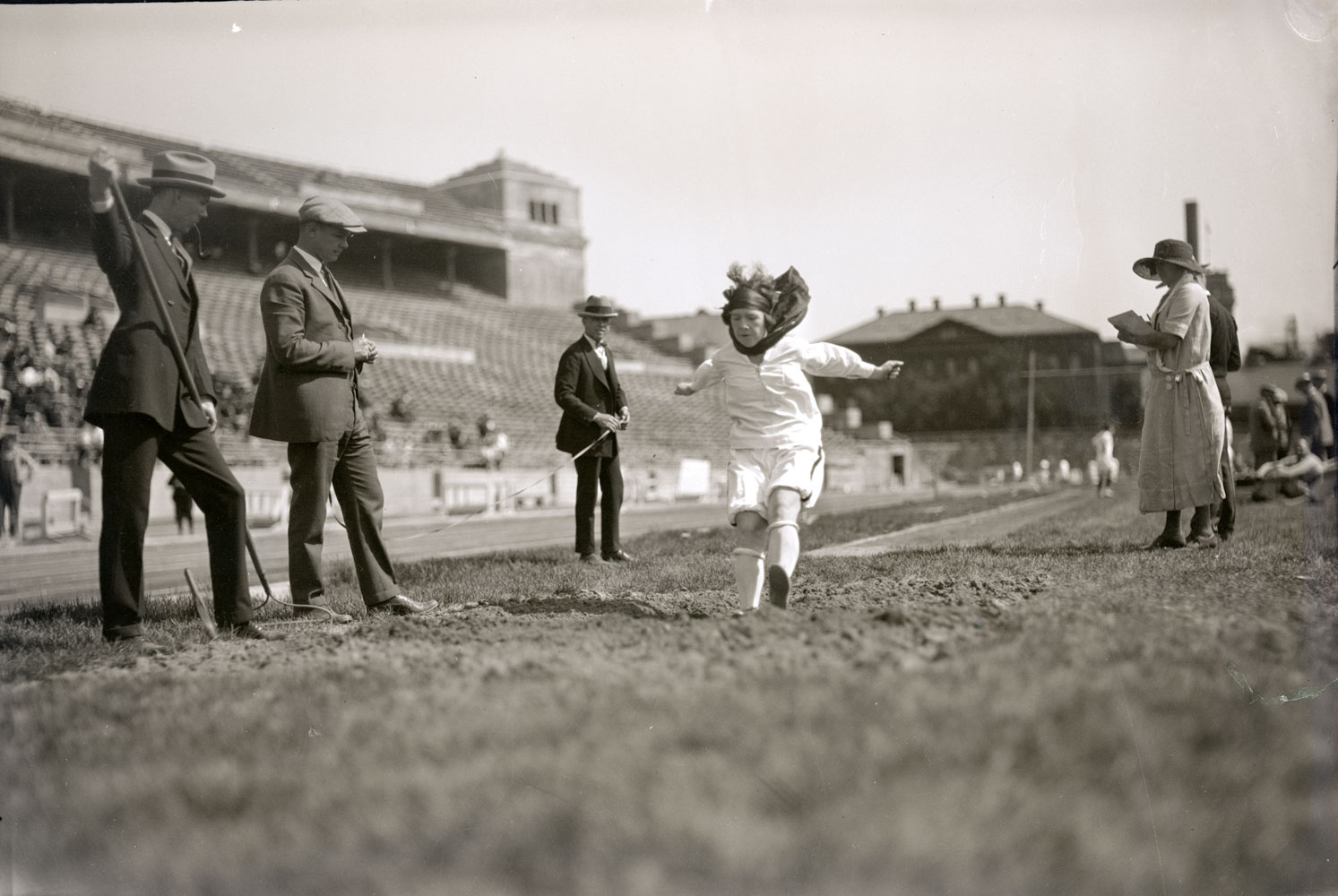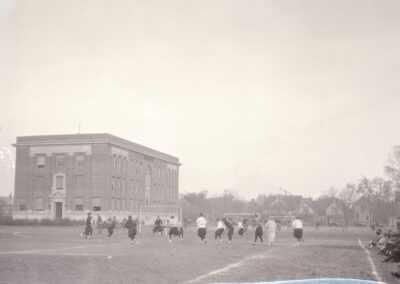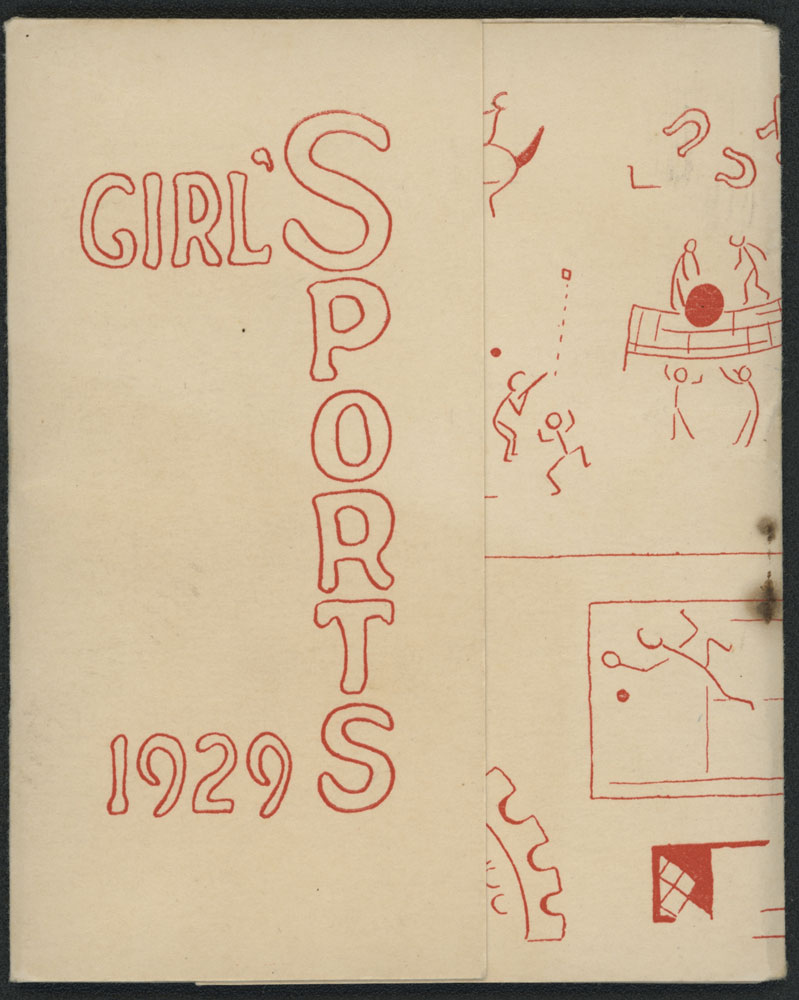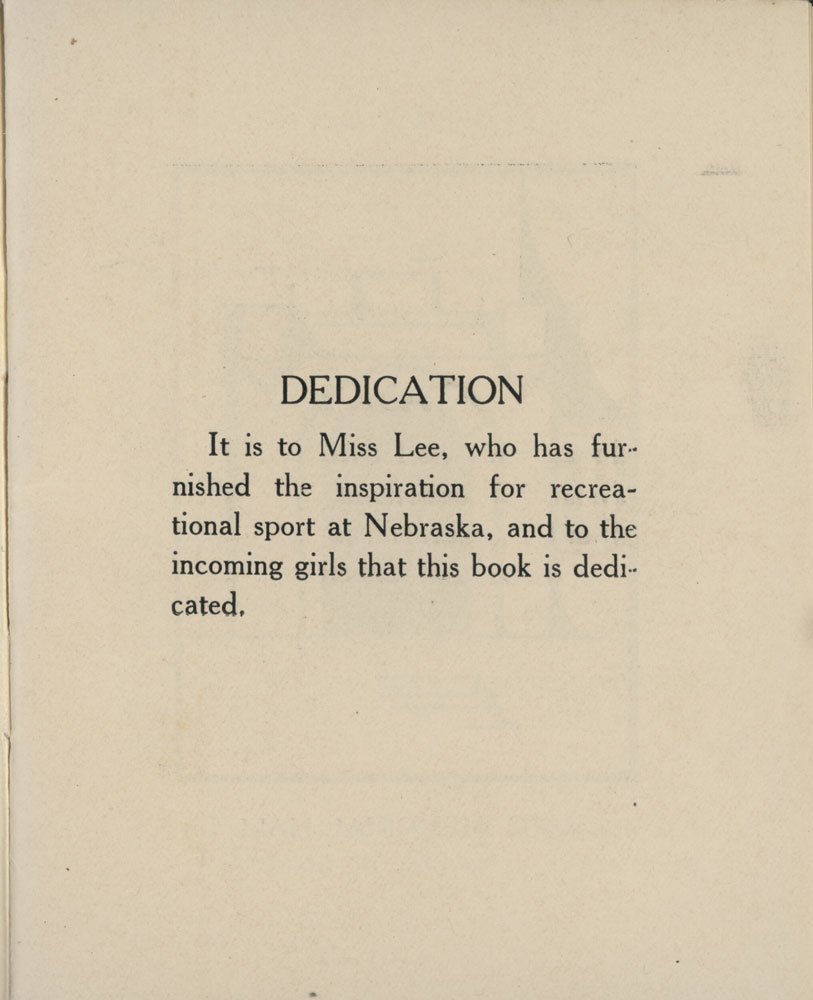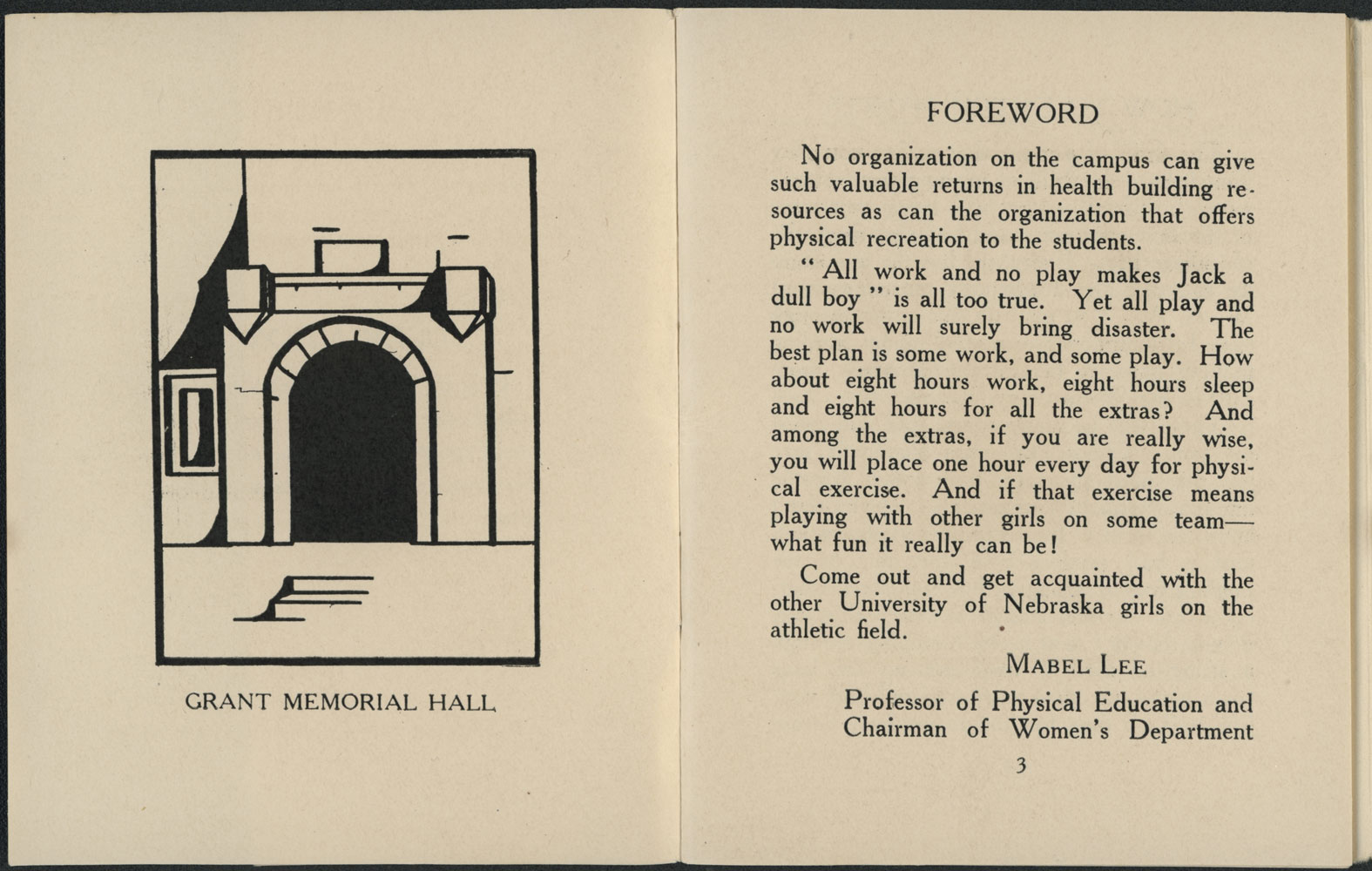Opportunity & Opposition
A Century of Women's Athletics at the University of NebraskaWomen at the University of Nebraska sought athletic opportunities as early as December 17, 1883, when they petitioned the Board of Regents for “an amount of gymnastic training that will be an equivalent for the military drill that is provided for gentlemen.”
By the mid-1890s the University established a physical training program for women, and women were not only exercising, they were becoming competitors. As the popularity of sports like basketball soared, teams began to face off. Tournaments and intercollegiate games allowed women to test their skills against multiple opponents.
But, instead of steady progress, the story of women’s athletics reveals inconstant opportunity and opposition to women playing competitively. This exhibit examines the history of women’s athletics at the University of Nebraska from the 1883 petition through the passage of Title IX in 1972.
Early Rise and Fall of Women’s Intercollegaite Athletics
FROM DRILLING TO DRIBBLING
In 1883 women at the University of Nebraska petitioned the Board of Regents for “an amount of gymnastic training that will be an equivalent for the military drill that is provided for gentlemen.” The Board of Regents appropriated $25 to outfit a room for women’s calisthenics in 1884. Within a decade the University had established a program offering women regular exercise and athletic instruction.
Basketball soon became a popular sport for women on campus. Invented by James Naismith in 1891, basketball was a relatively new game when Women’s Gymnasium Director Anne Barr introduced it to classes in 1896. That year the first interclass games were played. In 1897 Louise Pound joined as team captain, and the players took on their first outside opponents, a team from Council Bluffs, Iowa.



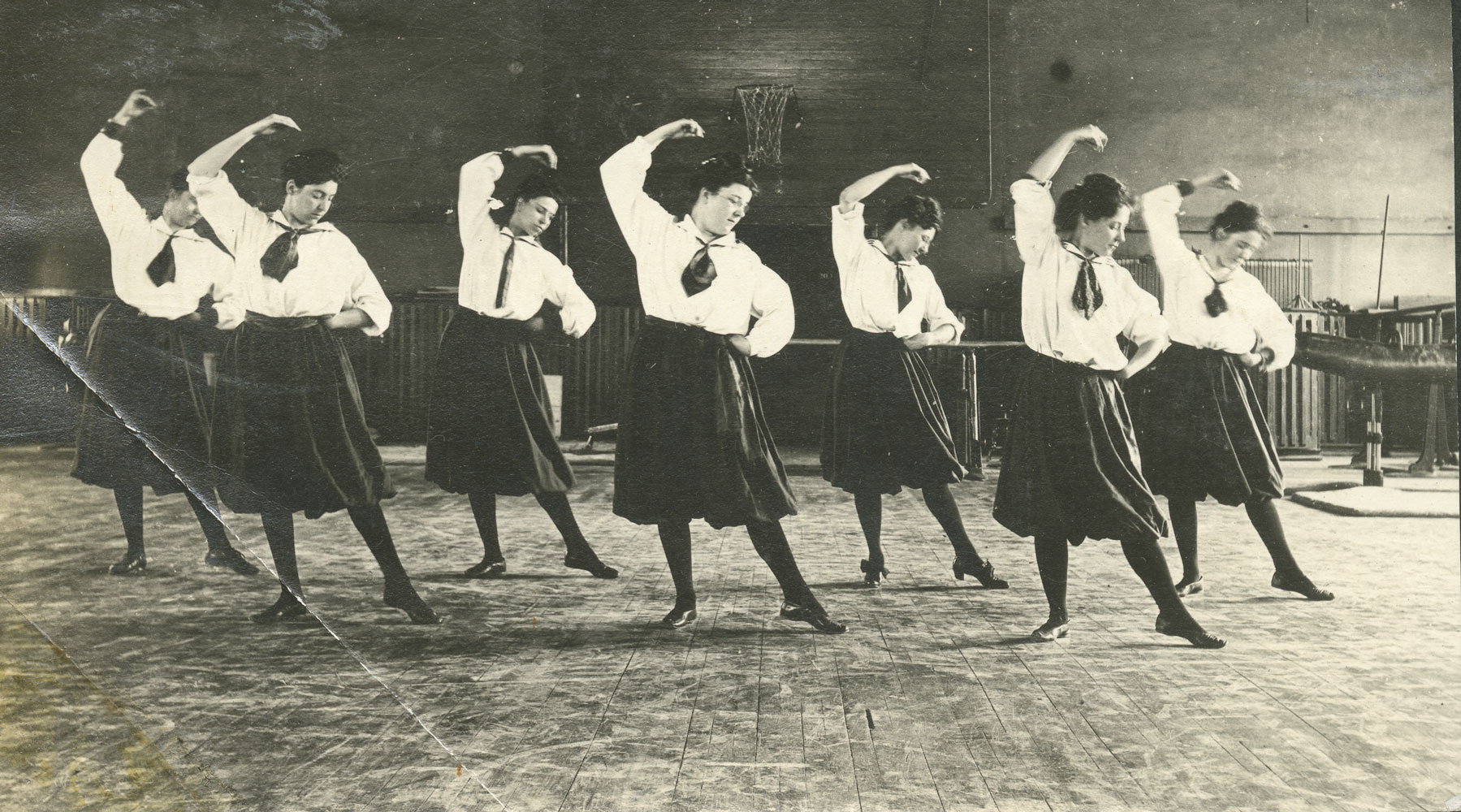
Practicing dance in physical education class, about 1900‒1904 photo from Alice Towne Deweese’s scrapbook
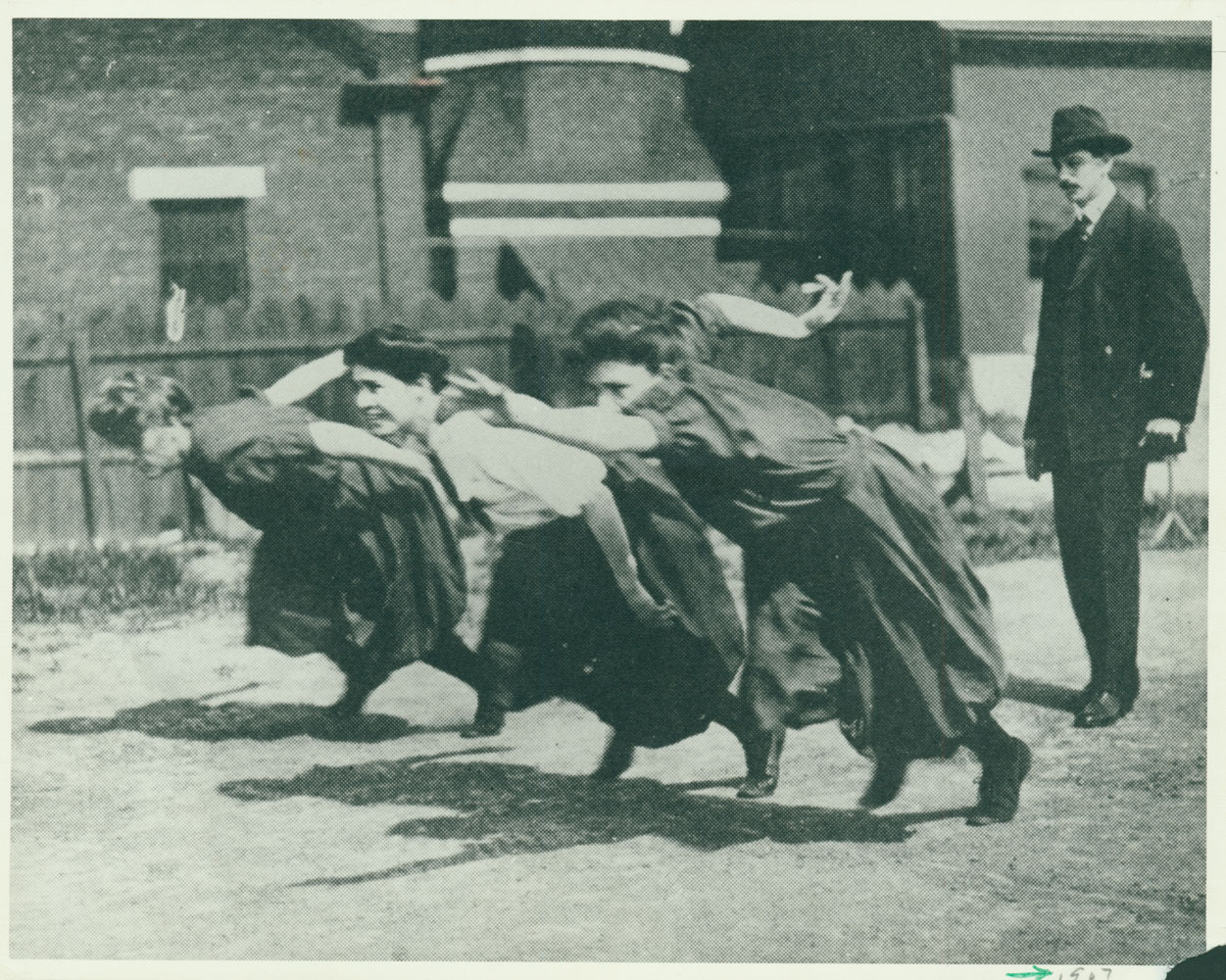
Dashing from the starting line, 1907
Women’s gymnastic training included dance, calisthenic drills, and sports like basketball.
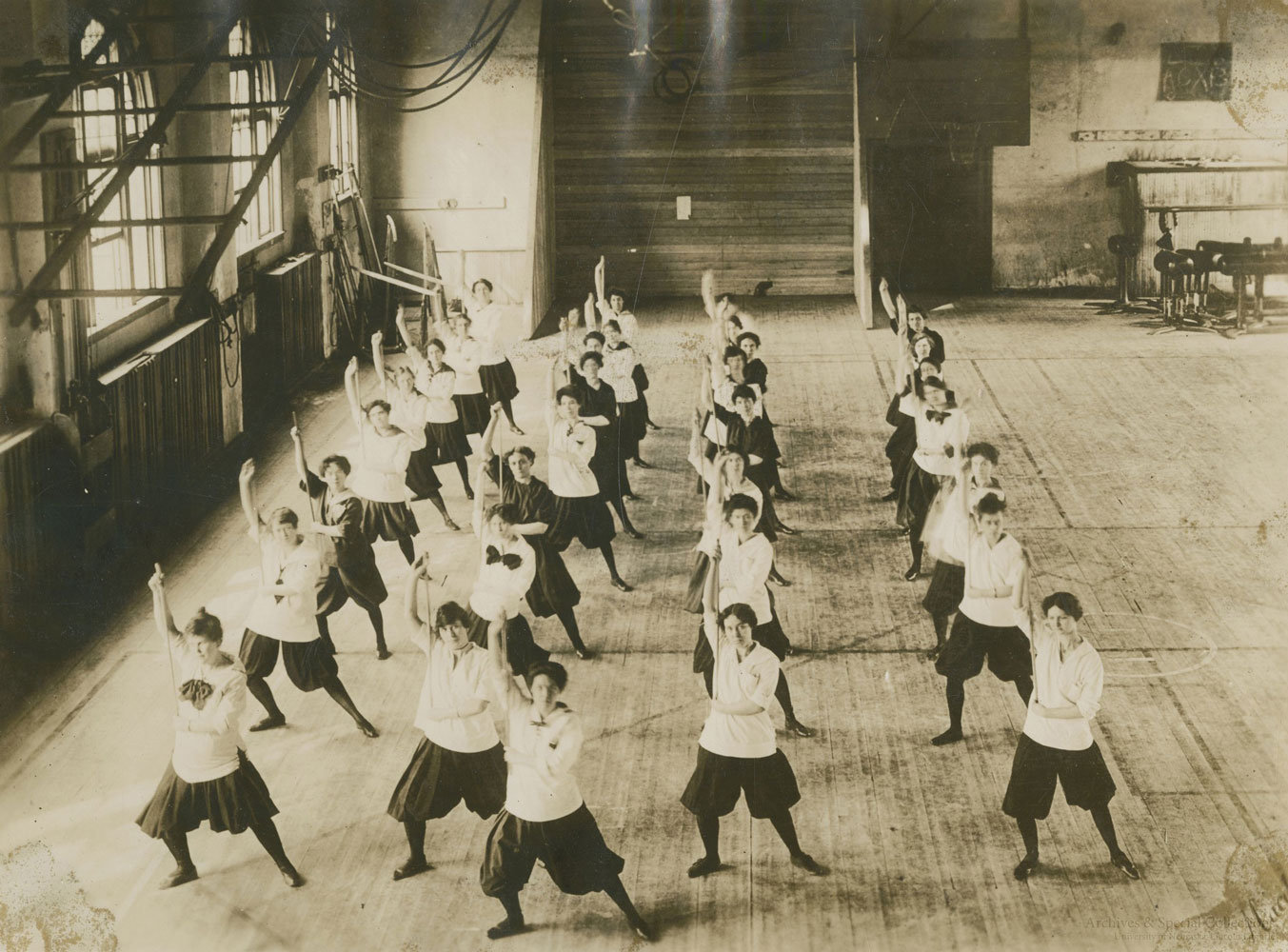
Physical education department, lincoln woman’s club, 1914–1915 Photo from Alice Towne Deweese’s scrapbook
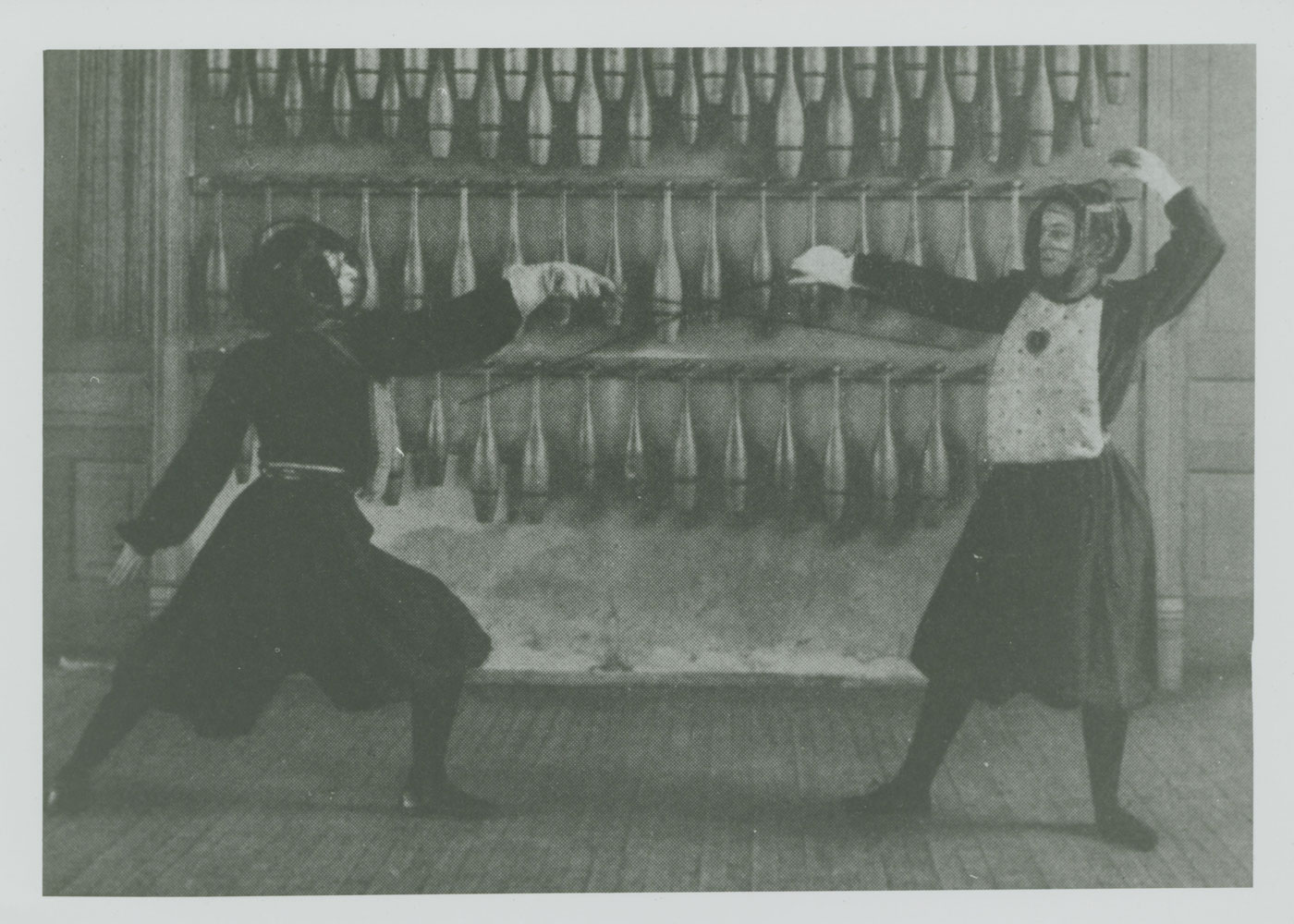
Edith Schwartz and Adelloyd Whiting fencing in the gymnasium, 1898 In 1899 Adelloyd Whiting, Alberta Spurck, and Mildred Parks were appointed gymnasium assistants at fifteen cents per hour. Whiting’s scrapbook, “My University Days, 1894–1902,” is an important source for early images of women’s sports at the University.
To the left is the Petition for Women’s Calisthenic Training
Students wrote to the Board of Regents, December 17, 1883, requesting women’s calisthenic training equivilant to the men’s military drill.
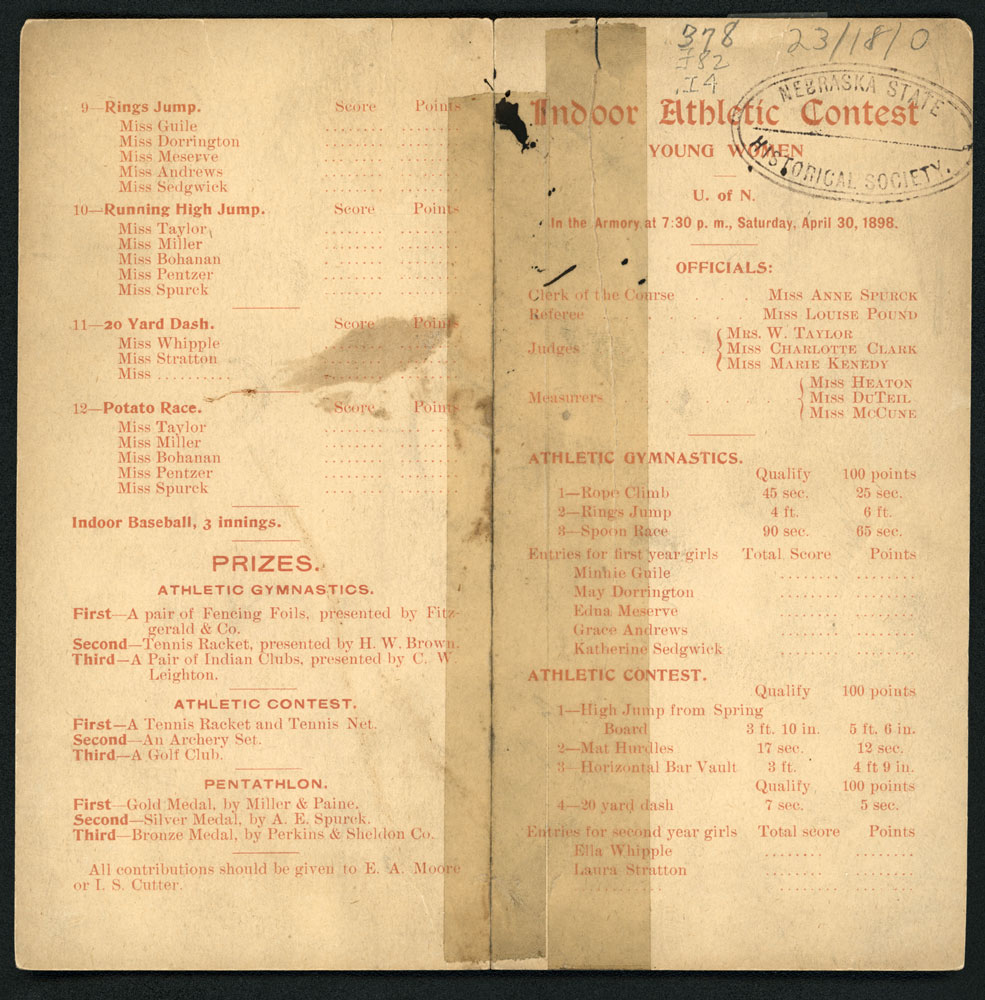
“A little more than twenty five years ago, when women were still restricted in their physical activities by public opinion, the game of basketball was introduced into gymnasium classes…. The Nebraska girls immediately became most enthusiastic over the game. It was the first real sport offered them which called into play the physical energy so long pent up by social tradition.”
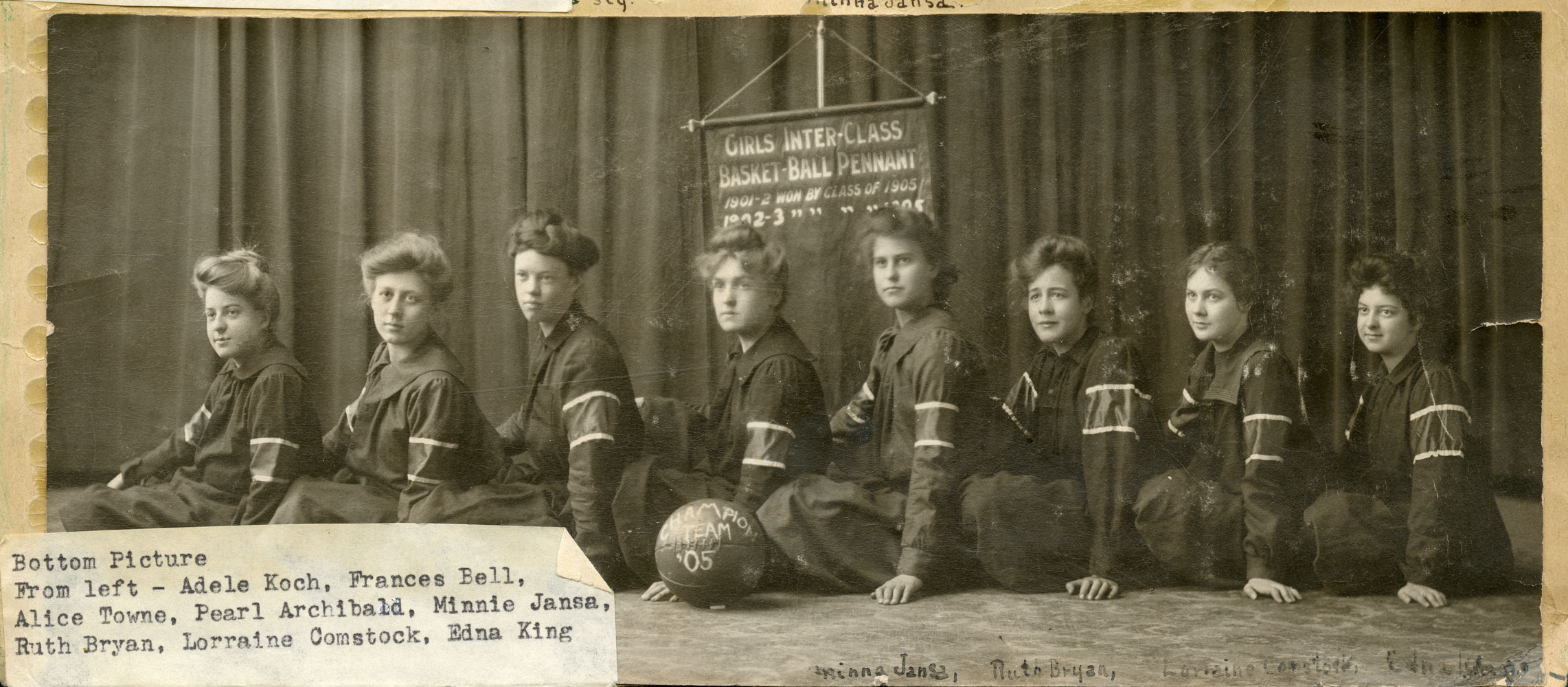

From Adelloyd Whiting’s scrapbook, “My University Days, 1894–1902.” The students are identified as: Alice Sparks, Gertrude Macomber, Minnie Guile, Adelloyd Whiting, Amy Robinson, Clara Fowler, Edith Higgins, Hannah Pillsbury, and Mabel Guile.

University of Nebraska Young Women’s Indoor Athletic Contest, 1898
Held April 30, 1898, the contest featured a dozen events and two games of indoor baseball. Prizes included athletic equipment and medals
Program from the second annual interclass basketball tournament Courtesy of History Nebraska, RG0912.AM: Louise Pound Papers
VARSITY BASKETBALL BROADENS COMPETITION
Competition expanded and included an annual tournament with other local teams beginning in 1900. The top team was awarded a Russian samovar donated by Anne Barr. Winning the tournament for three consecutive years, the University of Nebraska women became the trophy’s permanent owners.
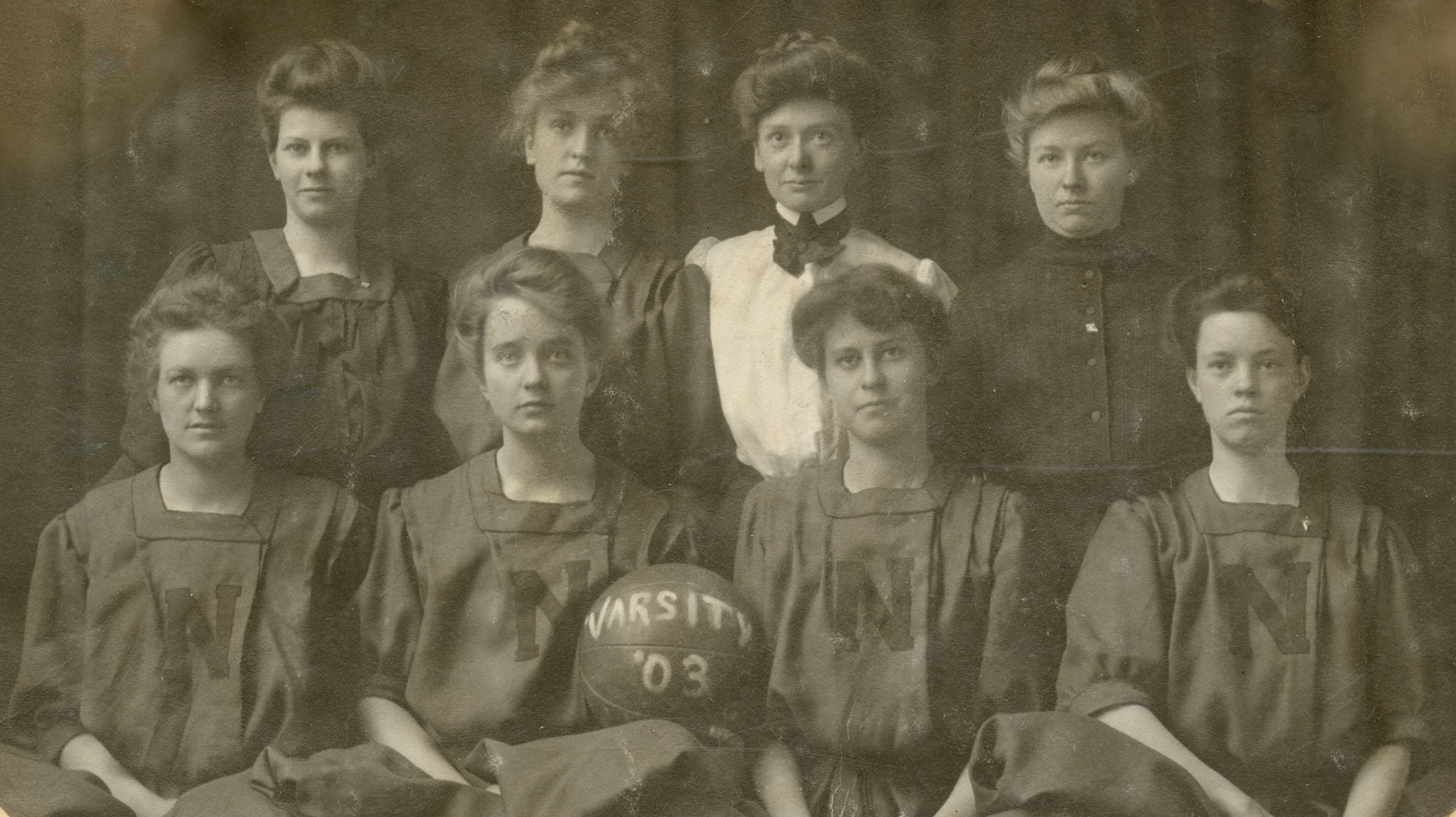
Women’s varsity basketball team, 1902–1903 Top row: Edith Craig, Pearl Archibald, manager Louise Pound, Zora Shields Bottom row: Cora Scott, Elva Sly, Minnie Jansa, Alice Towne
“A review of the history of basket ball among the young women of the University of Nebraska shows that the symmetrical development of mind and muscle has been attained in high degree.”
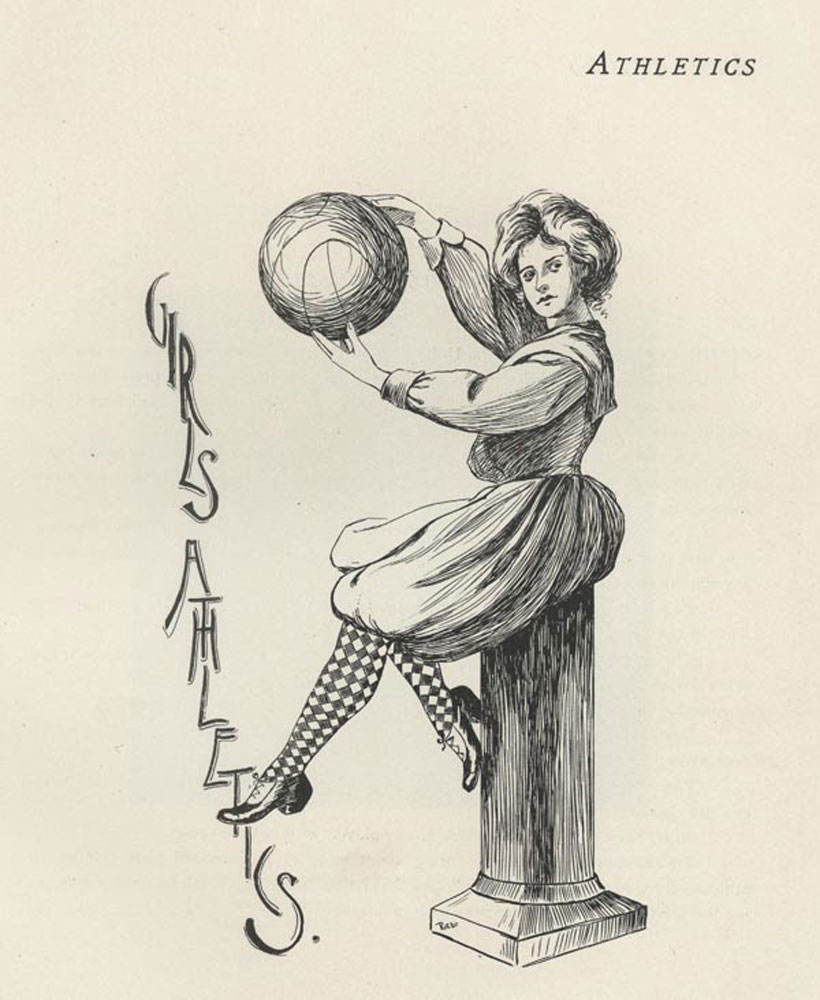
Illustration from The Sombrero, 1902
In November 1901 the team played its first intercollegiate match and defeated the University of Missouri. The 1902 University yearbook, The Sombrero, highlighted the team’s successful record. Anticipating a promising future, the yearbook reported efforts to bolster intercollegiate athletics.
Only six years later, in April 1908, the Board of Regents voted to end intercollegiate athletics for women.


“Girls’ Basket Ball in the University of Nebraska: Decennial Souvenir, 1896–1906” Head of Women’s Physical Education Anne Barr Clapp (back) and team manager Louise Pound (middle row, center) with Varsity Basketball Team, 1900–1901 Forwards, Eleanora Miller and Blanche Emmons; Guards, Elva Sly and Ida Taylor; Centers, Minnie Guile and Hannah Pillsbury
THE FINAL SEASON
As women’s varsity teams sought opportunities for intercollegiate competition, opposition emerged. Dean of Women Edna Barkley was a prominent opponent.
Barkley fought to prevent the women’s basketball team from playing home and away games against the University of Minnesota in 1908. At that time, women’s athletics were governed by the Athletic Board. The Board overruled the Dean’s objections, and the women played both games.
After a tough 22–28 loss in overtime at home, the women spent weeks drilling and tightening up their skills under the leadership of team manager Louise Pound and trainer Ina Gittings. The team traveled to Minneapolis, Minnesota, for what would be its final intercollegiate game, winning 9–3 on Saturday, April 4, 1908.
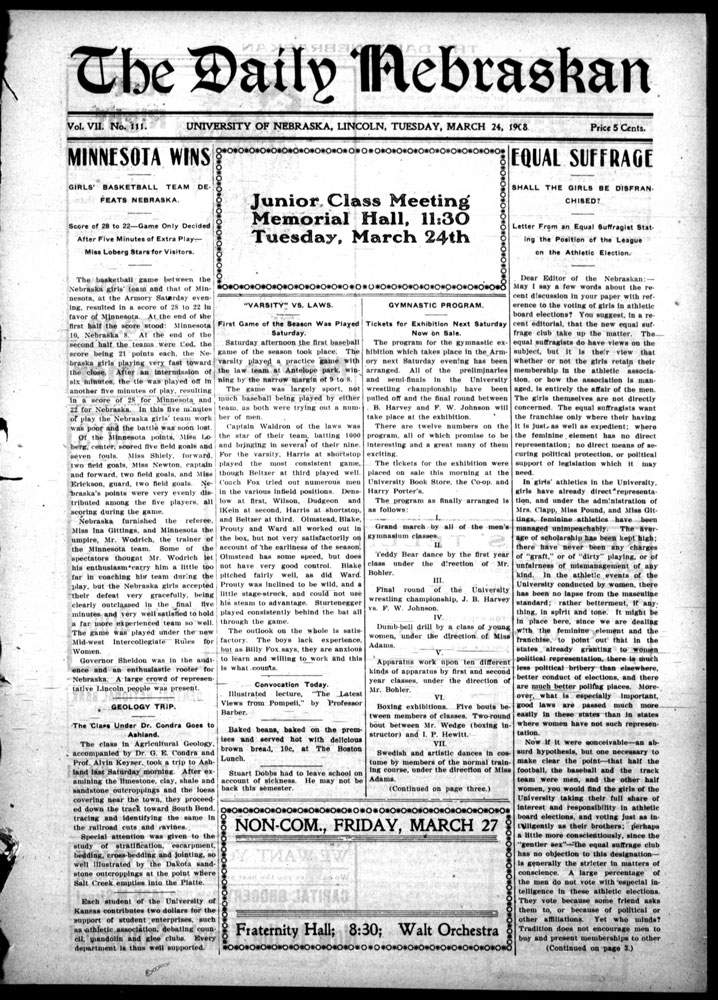
On March 24, 1908, top headlines on the Daily Nebraskan’s front page highlighted the women’s varsity basketball game against Minnesota and the proposal to bar women students from voting in Athletic Board elections.

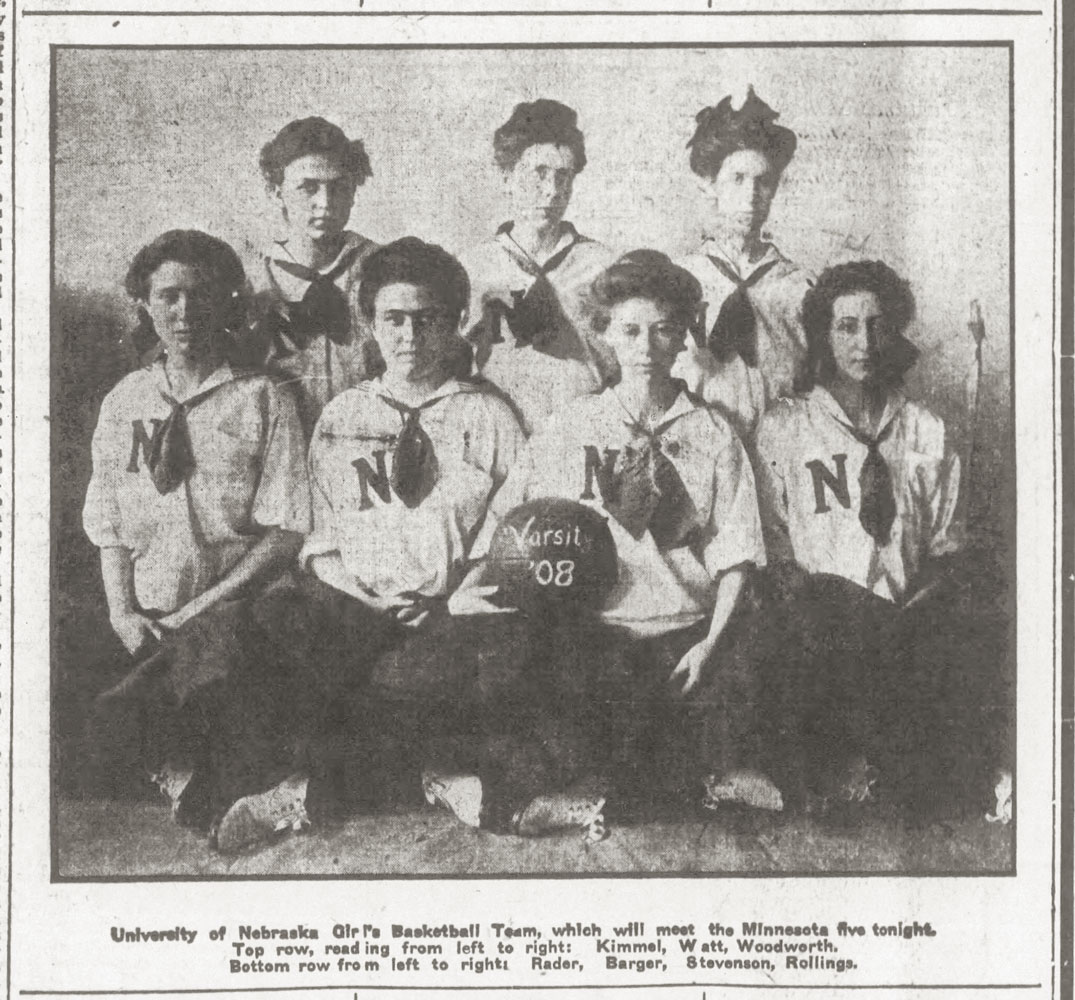
The Nebraska State Journal, Saturday, March 21, 1908, featured the varsity basketball team before its home game against Minnesota.
“On hearing of negotiations which are being carried on between Minnesota and Nebraska relative to a girls’ intercollegiate basketball game, a complaint was filed with the Athletic Board asking that this proposed game be cancelled.”
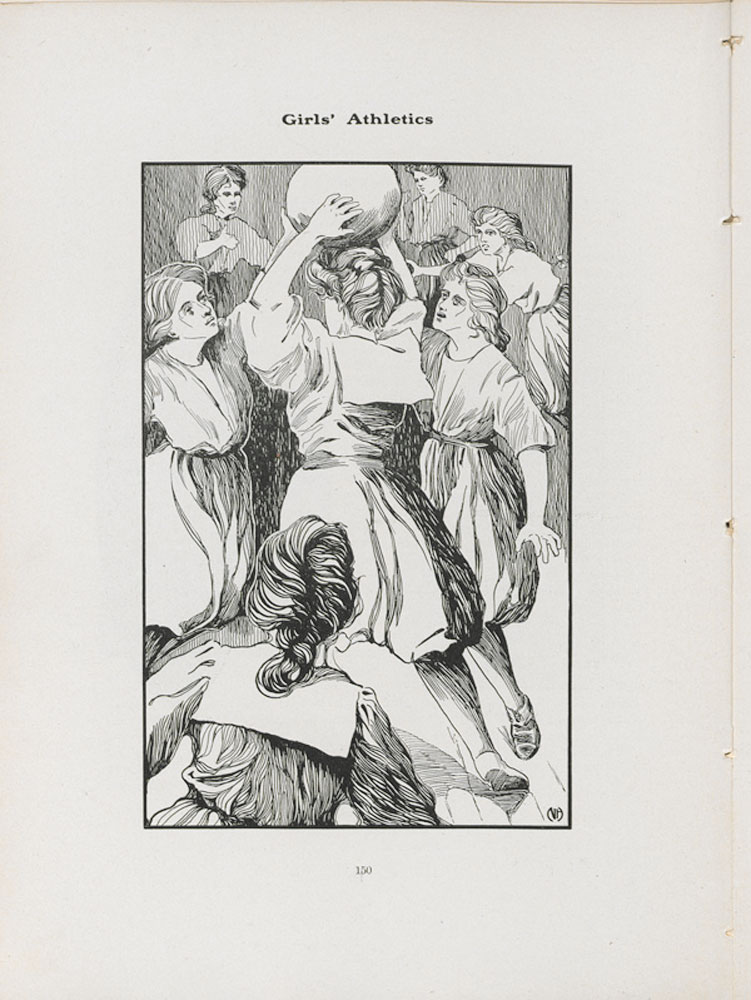
Illustration from The Sombrero, 1906
WOMEN’S INTERCOLLEIGATE ATHLETICS ENDS
In April 1908 the University Senate made significant changes to the Athletic Board. The changes included removing women’s sports from the Athletic Board’s oversight and revoking women’s ability to vote in Athletic Board elections. This left women’s athletics without a governing body or a system of support. On April 7 the Board of Regents assigned their Property Committee the task of considering Dean of Women Edna Barkley’s concerns about women’s intercollegiate athletics. Newspaper coverage and Alice Towne Deweese’s memoir suggest Barkley may have cited the physical and
emotional toll of higher-level competition as well as the distraction from classwork generated by big games. During the Regents’ meeting April 24, 1908, members of the Property Committee reported their recommendation, “that the young ladies of the university student body shall not engage in interstate games and contests.” The Regents accepted and adopted the recommendation, eliminating women’s varsity intercollegiate athletics for nearly six decades.
Left: The Lincoln Star, Friday, April 24, 1908
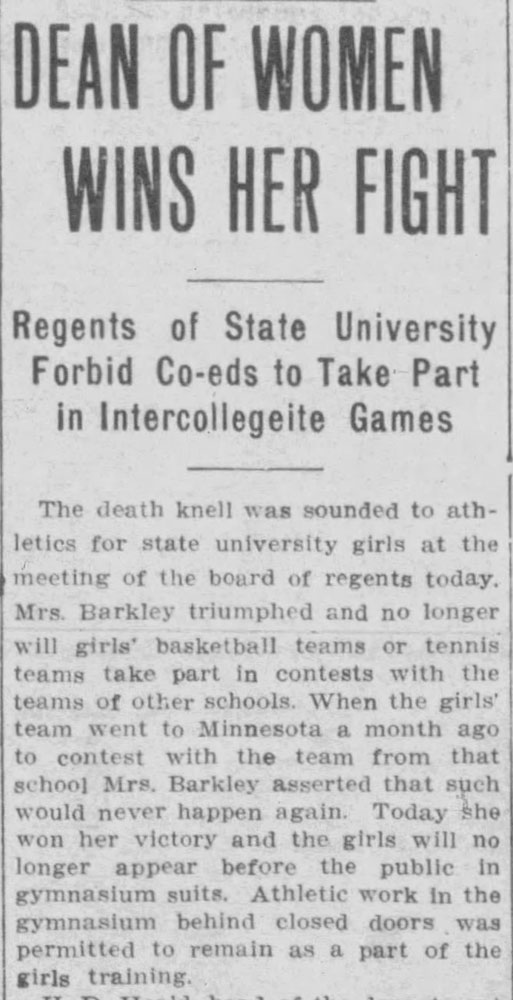
Anne Barr Clapp
After assisting with women’s physical training classes at the University of Nebraska and serving as an instructor in the program, Anne Barr became the women’s gymnasium director in 1895.
She introduced women’s basketball at the University and helped develop early teams. Barr also founded a course of study for students to earn a certificate in teaching physical education.
Barr attended the Chautauqua (New York) Summer School of Physical Education and returned many summers as an instructor. She continued learning at the Harvard Summer School of Physical Training and at gymnastics schools throughout Europe. On her travels, she acquired the samovar that served as a trophy for women’s basketball teams.
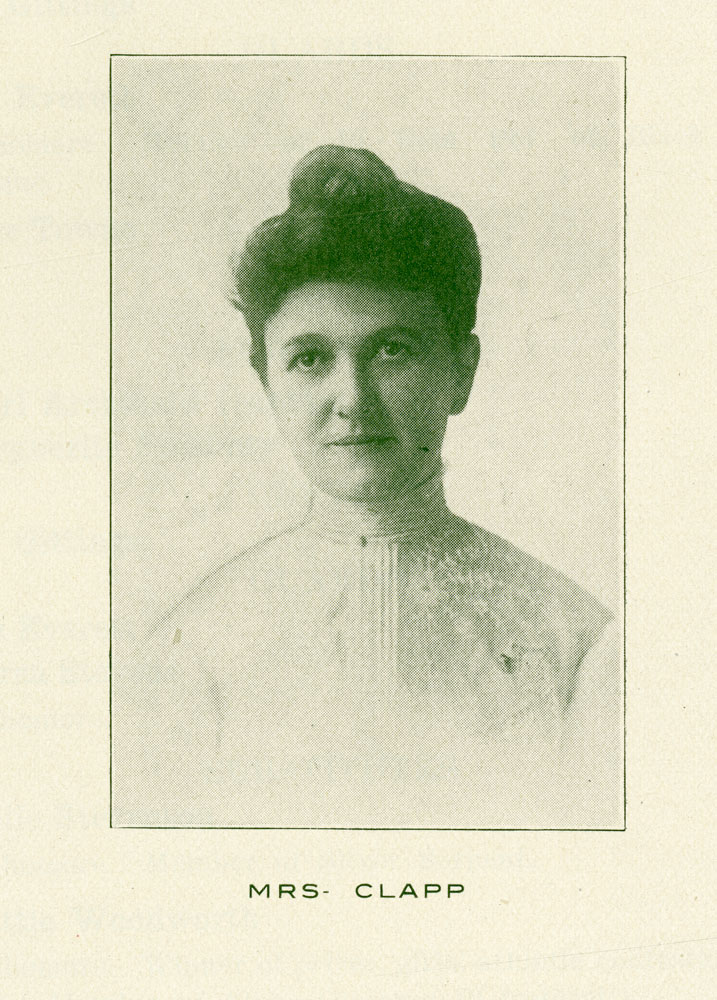
“Miss Pound occupies the unique position of having earned two ‘N’s, the girls’ as a member of the basketball team and the men’s as a former university champion in men’s as well as women’s tennis . . .”
“Practically all of the progress of athletic and gymnastic work in Nebraska is due to Mrs. Clapp, either directly or through the agency of graduates of the normal course in physical training . . .”
Louise Pound

Well known for her athletic achievements, Louise Pound led the varsity basketball team as captain in the 1897–1898 and 1898–1899 seasons. As a faculty member in the English department, she supported the team by serving as its manager.
Pound continued to champion women’s athletics even after the Board of Regents prohibited intercollegiate competitions. She served on the advisory board of the Women’s Athletic Association, which students founded in 1917 to organize and regulate athletic competitions for women and provide an award system for women athletes.
Pound received bachelor’s and master’s degrees from the University of Nebraska and a PhD from the University of Heidelberg.
Edna Barkley
As Dean of Women from 1905 to 1909, Edna Barkley’s responsibilities reflected a parental role toward women students. She shaped and enforced rules governing women’s behavior and appearance. She acted as an advisor, meeting with students personally. She also advocated for study and social spaces on campus as well as improved women’s gymnasium facilities and additional physical education instructors. Barkley even proposed an employment bureau to help all students find jobs both during their enrollment and after graduation.
Her opposition to women’s intercollegiate athletics stemmed from her belief that the competitions were harmful to women. Her recommendation to the Board of Regents led to the elimination of women’s intercollegiate sports on April 24, 1908.
“The Dean of Women acts as adviser to women students upon all matters of interest and importance; secures special consideration for them when needed; sees that they reside in desirable places; and that the sick receive proper care. She gladly corresponds with the parents of women students touching their welfare.”
Reporting on the Board of Regents decision, the Nebraska State Journal presented Barkley’s point of view: “One of her reasons for objecting to the playing of the games was that such matches had a bad effect on the health of the girls.” After she left the Dean of Women position, Barkley focused on social issues. She spent nearly a decade campaigning for women’s suffrage and continued political involvement as a member of the League of Women Voters. In 1971 funding from the estate of Edna Barkley and her husband William provided for construction of the Barkley Memorial Center to support programs in audiology, speech-language pathology, and special education.

Alice Towne Deweese
As a student at the University of Nebraska, Alice Towne Deweese enjoyed physical education classes and playing on interclass and varsity basketball teams. In 1908 she was appointed Acting Director of the Women’s Gymnasium. By then, her attitude toward women’s varsity athletics had changed. When Dean of Women Edna Barkley invited Deweese to lunch for a chat in spring 1908, Deweese surprised Barkley by agreeing varsity athletics produced, “severe strain on the girls,”

“Buried in every game, in fact, the very core of it, is the thing that makes it appeal to thinking, emotional beings—competition.”
As a girl in Superior, Nebraska, Ina Gittings enjoyed outdoor activities and sports. Entering the University of Nebraska in 1902, Gittings played on the varsity basketball team and developed a reputation as a skilled athlete.
She earned an AB and Physical Education certificate in 1906. In 1909 she became Director of the Women’s Gymnasium and remained at the University of Nebraska until 1917.
Gittings believed competition helped women build leadership and collaborative skills.
and interclass sports should replace intercollegiate competitions. Deweese’s concerns about “fiercely contested competitions for University girls” began when she was a student assistant for the varsity basketball team. According to her memoir, the turning point came after a tough win over Minnesota, when she spent half an hour sitting with a player “while she sobbed in relief from tension.”
“The one place I felt relaxed and at home was in the gym.”
Ina Gittings
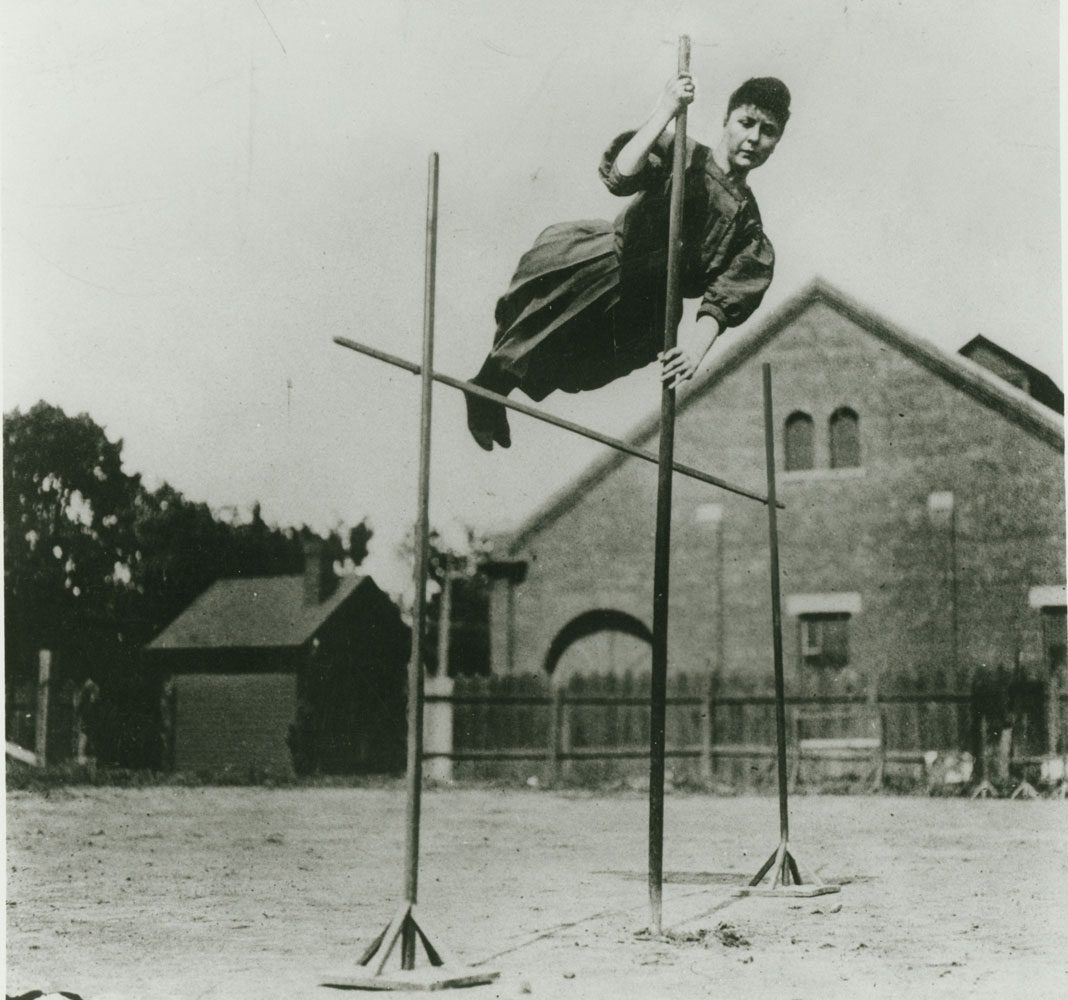
Throughout her career, she expanded athletic opportunities for women and supported recognition for their achievements as athletes.
At Nebraska, she began an annual track meet for women. As Director of Physical Education at the University of Montana, she developed a program of outdoor activities and awarded trophies to women’s teams — a first at the school. Gittings became the first Director of Women’s Physical Education at the University of Arizona, a position she held from 1920 to1955. There, she began the practice of awarding letters to women athletes.
Competition Continues on Campus
INTERCLASS COMPETITIONS 1909-1917
Although intercollegiate competition ended with the Board of Regents’ decision in 1908, women continued to play sports in physical education classes and interclass matches. The Physical Education Department oversaw women’s athletics until 1974, when the Athletic Department took on general supervision of women’s athletics in response to Title IX requirements. The decades-long entwinement of women’s athletics with physical education shaped the opportunities and limitations athletes encountered.
“The girls of the University of Nebraska staged their third annual track meet on Nebraska field yesterday. Though the field was swept by a gale of dust which often blinded the contestants, the meet was hurried through and held the interest of the spectators till its close.”
WOMEN’S SPORTS 1910-1916
WOMEN’S ATHLETIC ASSOCIATION
In March 1917 students founded the Women’s Athletic Association (WAA). Aided by physical education instructors Dorothy Baldwin and Jessie Beghtol Lee, they established the WAA to organize and regulate athletic competitions for women and provide a system of awards for successful competitors. Competitions provided an opportunity for women to discover and demonstrate their capabilities. Reporting the results of the three WAA basketball tournaments held in 1918, Jessie Beghtol Lee wrote:
“Time was when the college girl was supposed to do one of two things – she could bone hard and get herself a P.B.K. or she could dance and wield a feather fan at proms. But no girl was ever supposed to do both. This was the happy day when all ladies were supposed to be afraid of mice and faint at the sight of blood. But owing to a number of things – largely the passing of time and the unceasing demand made by women for recognition in every phase of life—this has all been changed. Women can make munitions, they can run factories, they can plow farms — and they not only can do it but they are doing it every day of their lives . . . And not only can the college woman work to point and purpose, but she can play, keeping the rules, and obey the dictates of the referee and umpire quite as well as anyone . . . These tournaments enabled one hundred and fifty girls to compete in actual playing for prizes, gave healthful and pleasant recreation for many more, and proved conclusively that girls’ athletics, when managed by girls of character and discretion, can be made one of the most important influences of college life.”
Images are from the Alumni Roundup on June 6, 1924
Image 1: Racers cross the finish line at the Alumni Roundup track meet, June 6, 1924
Image 2: During a track meet held as entertainment for the Alumni Roundup on June 6, 1924, Margaret Hymer set a new state broad jump record at 14 feet, 8 3/4 inches. The woman jumping in this photo from the meet is not identified.
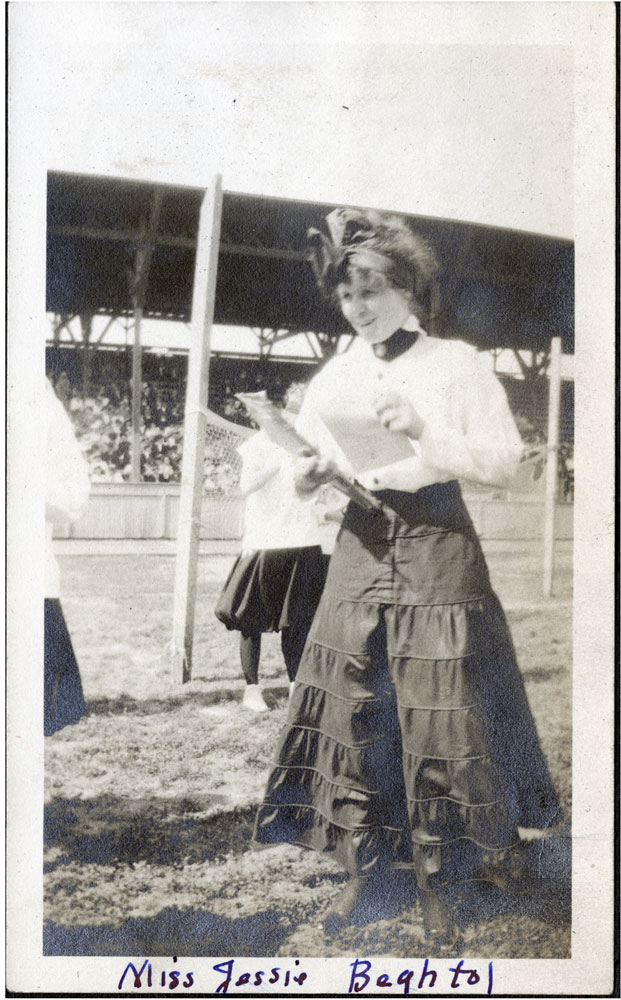
WAA SPORTS 1923-1924
The 1923 WAA constitution outlined a scaled system for awarding points, which rewarded both participation and accomplishments.
Athletes received points for membership on class and intramural teams and for individual sports. The number of points awarded ranged from 100 points for membership on primary class teams to 5 points for third place in a track event.
“Soccer and broken toes are synonymous. Early every fall the girls who come out for this sport develop a bad case of the limps. Such has been the history of this sport in Nebraska ever since it was introduced here in the fall of 1917. Nebraska was among the first two colleges to adopt soccer for women. In 1917 there were only two first teams, an upper class team consisting of juniors and seniors and a lower class team made up of freshmen and sophomores.”
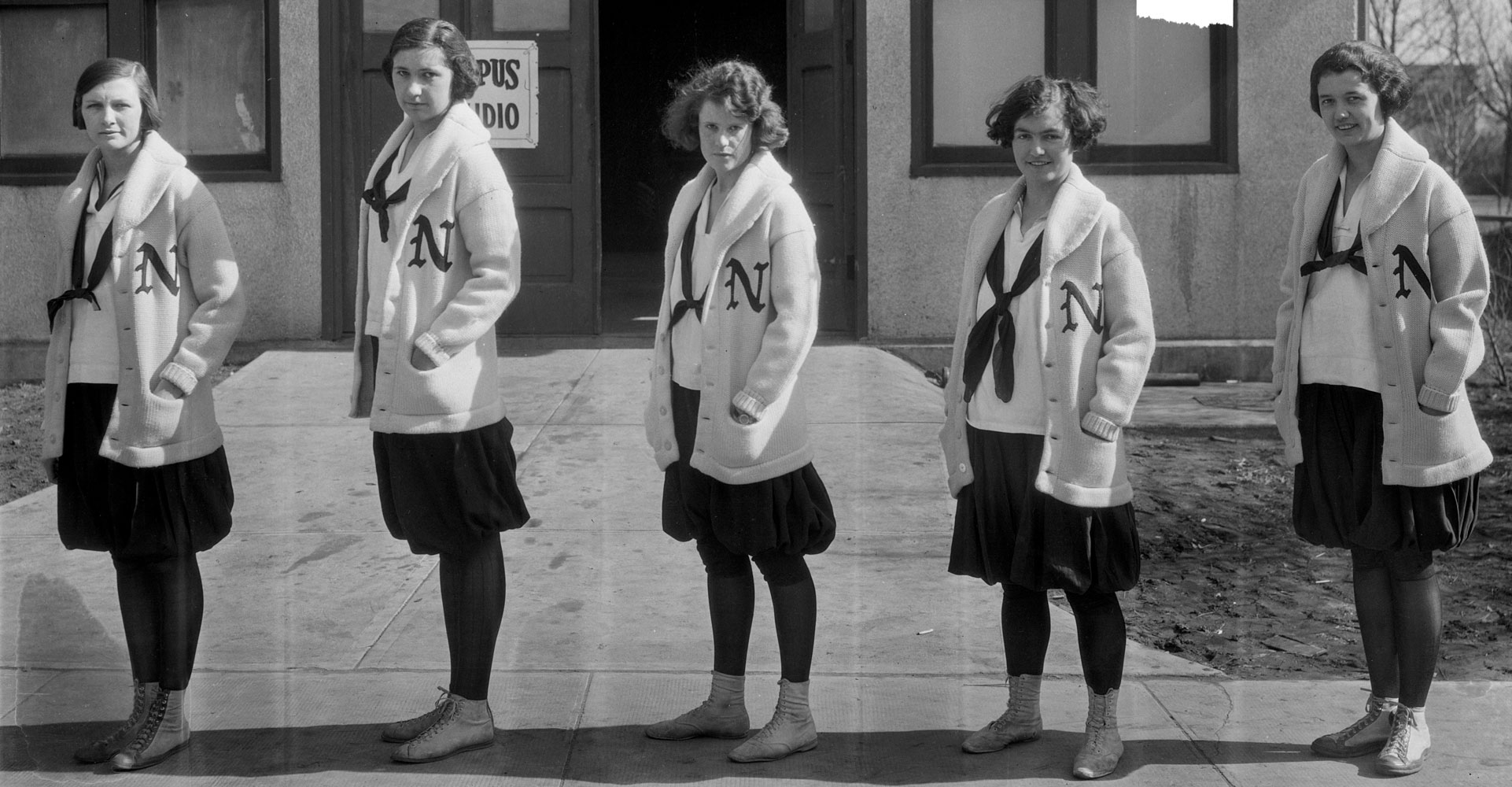
Five of the 1924 letter winners pose for their yearbook photo outside the campus studio. The WAA awarded letters to women who had accumulated 1,200 points according to the association’s point system.
A SPORT FOR EVERY GIRL AND FOR EVERY GIRL A SPORT
Mabel Lee’s Influence
As Director of the Women’s Physical Education Department from 1924 to 1952, Mabel Lee influenced women’s athletics at the University of Nebraska for nearly thirty years.
Lee opposed women’s intercollegiate athletics. Instead, she favored intramural sports and play for play’s sake. Lee felt intramural sports expanded opportunities to all women, regardless of their athletic skill. Intercollegiate athletics, on the other hand, would limit participation to highly-skilled athletes.
She also believed women should be safeguarded from physical and emotional challenges associated with intense competition. She worried students would be exploited if their athletic contests became spectator sports generating ticket revenue and pointed to men’s intercollegiate athletics as an example of the danger.
A leader in the field of physical education, Lee became the first woman president of the American Physical Education Association in 1931. She rose to prominence in national and regional organizations and frequently wrote and gave speeches related to women’s physical education and sports.
In 1948 Lee won the Luther Halsey Gulick Award for long and distinguished service, the American Association for Health, Physical Education and Recreation’s highest honor. The association honored her again by establishing the Mabel Lee Award in 1976 to recognize outstanding young professionals.

ARGUMENTS AGAINST WOMEN’S COMPETITIVE ATHLETICS
Mabel Lee included a section titled “Competition” in her 1937 book, The Conduct of Physical Education: Its Organization and Administration for Girls and Women. Arguing against women’s interscholastic athletic competition, Lee focused on women’s basketball as an example to illustrate competition’s drawbacks. According to Lee:
1. It produces both physical & emotional strain which is harmful to the girl.
2. The temptation to participate during the menstrual period is a serious hazard to future health.
3.It is more frequently accompanied by rowdyism than by cultural influences, which hinders the best personality development of all who are involved.
4.It leads to neglect of studies on the part of players and to neglect of other important extracurricular activities and teaching on the part of the coach and sponsors.
5.It brings undesirable publicity to girls.
6.It leads to a distorted conception of the values of athletics.
7.Whatever values might exist in such procedure can be gained only at too great a sacrifice of other values.
8.A long program of intense competition seriously curtails the girls’ freedom to pursue a normal life and brings many unwholesome experiences as happens to boys and men who are varsity players involved in commercialized athletics.
9.Such a program breeds the “coach” type of instructor as opposed to the “educator” type and the “professional” type of player as opposed to the “amateur” type.
(Source: The Conduct of Physical Education: Its Organization & Administration for Girls & Women, pages 435-436)
Funding: Physical Education vs. Intercollegiate Athletics
As early as 1926, inadequate funding to support both women’s varsity sports and physical education reinforced opposition against women’s intercollegiate athletics. Opponents claimed “the few” skilled enough to play varsity sports would benefit at the expense of “the many” physical education majors if the Women’s Physical Education Department spent general funds on intercollegiate teams. In contrast, men’s physical education and men’s athletics were considered distinct from one another and received separate funding. Military drill provided basic physical education for men, and men were provided opportuntities for both intramural and intercollegiate sports.
“No school–and especially not Nebraska–has a sufficient staff and equipment to turn out varsity teams for various sports of the year, and at the same time to carry out a correct program of physical education for the remaining University women.”

Women’s Athletic Association Concessions, 1927

The Daily Nebraskan November 3, 1926
The Women’s Athletic Association raised money selling concessions at men’s football and basketball games. Following principles adopted by the Athletic Conference of American College Women in 1924, the WAA opposed women’s intercollegiate athletics and did not provide funding to support varsity teams.
Instead, WAA funds supported annual charity projects and sponsored lectures, alumni luncheons, banquets, and parties. The WAA purchased equipment used by both the intramural program and the Physical Education Department. From 1934-1952, the WAA leased land north of Bethany, where they maintained a cabin for group outings.
Women’s Athletic Association Empahsizes Recreation
The WAA brochure from 1929 reveals Mabel Lee’s influence on the organization. With a dedication to Lee and forward written by her, the brochure persuades students to try intramural sports: “The worse you are, the better we like it, because the more progress you’ll make and progress is what we crave. Besides, Intramurals are not out to make records or record-breakers. They are here for the sole purpose of making you happy, and the way they do it will make you marvel.”
To the right: Women’s Athletic Association Brochure, 1929
Rejecting the Old Idea of Playing to Win
In summarizing the organization’s history, the 1931–1932 WAA President’s report described the WAA’s early years as: “Much big varsity activity midst cheers and earning great sweaters and numerals and sporting them to the world seemed to be the platform of the WAA.” According to the report, by 1928 the WAA aimed to, “if possible grow away from this old idea of playing to win; of getting out to get practices to pile up points toward a big letter to wear on a sweater; to reduce the desire for individual awards; and to increase participation, to make it possible for every girl in the University to participate in some sport activity.”
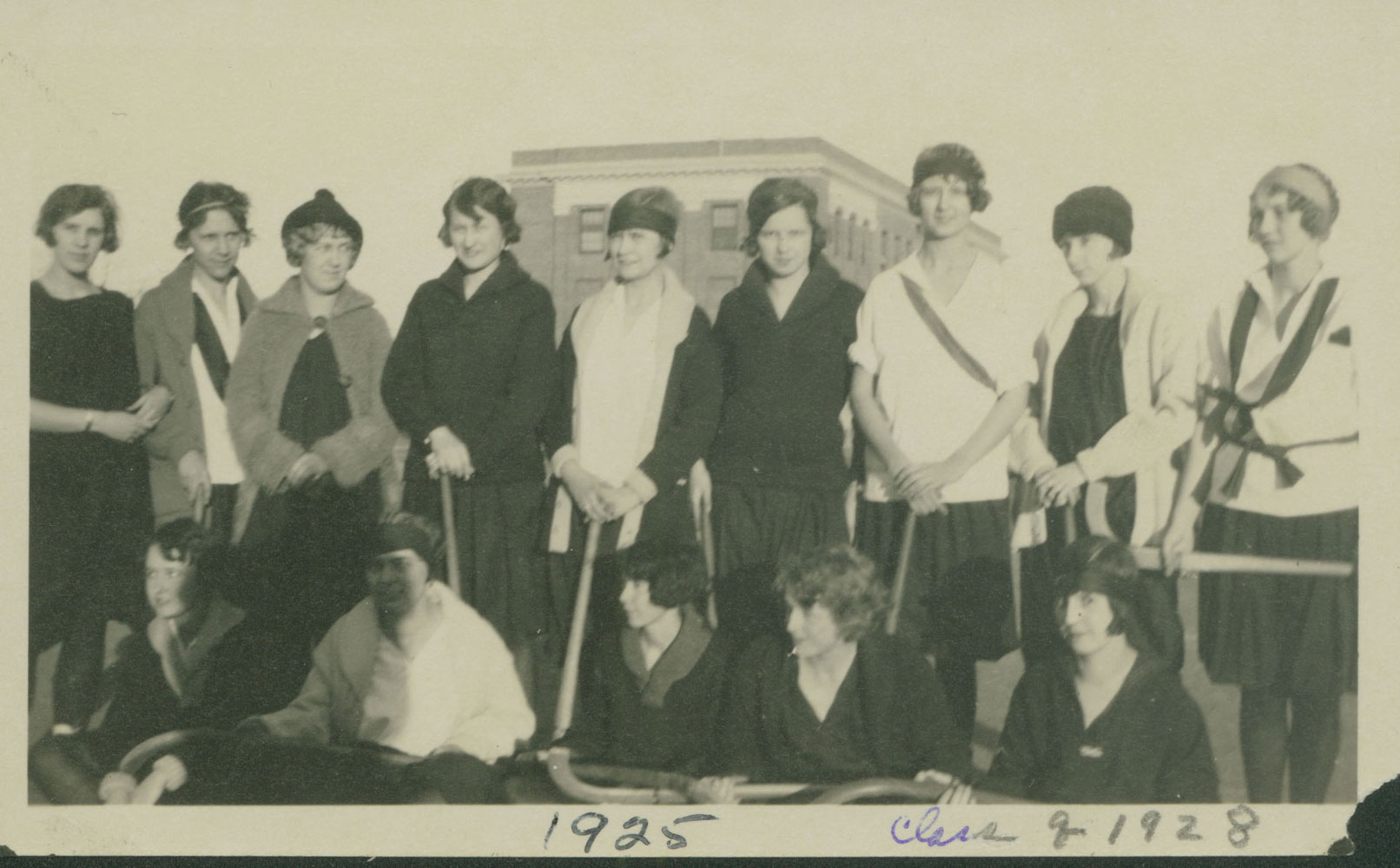
Class of 1928 field hockey team in 1925
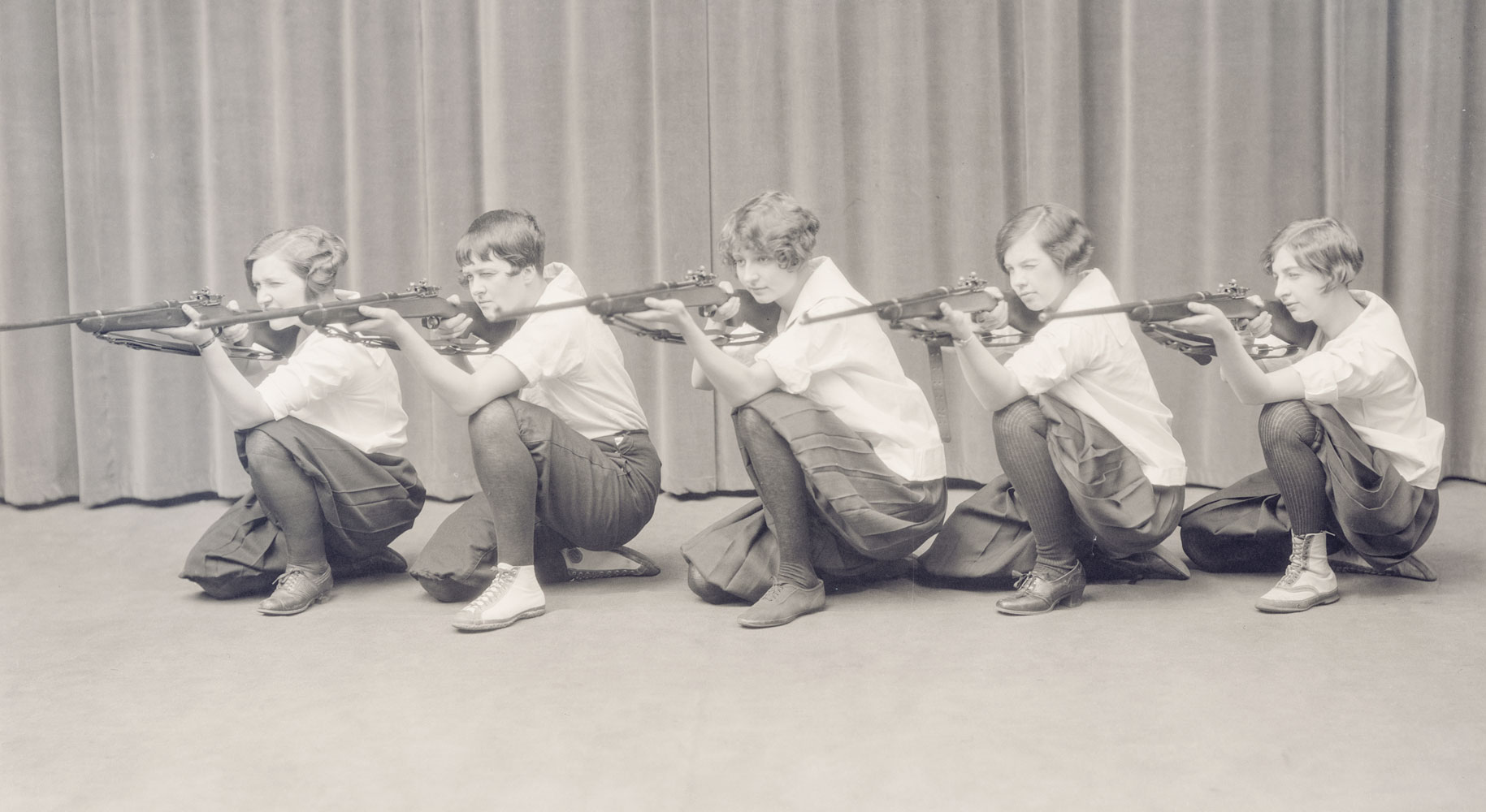
Rifle, 1927
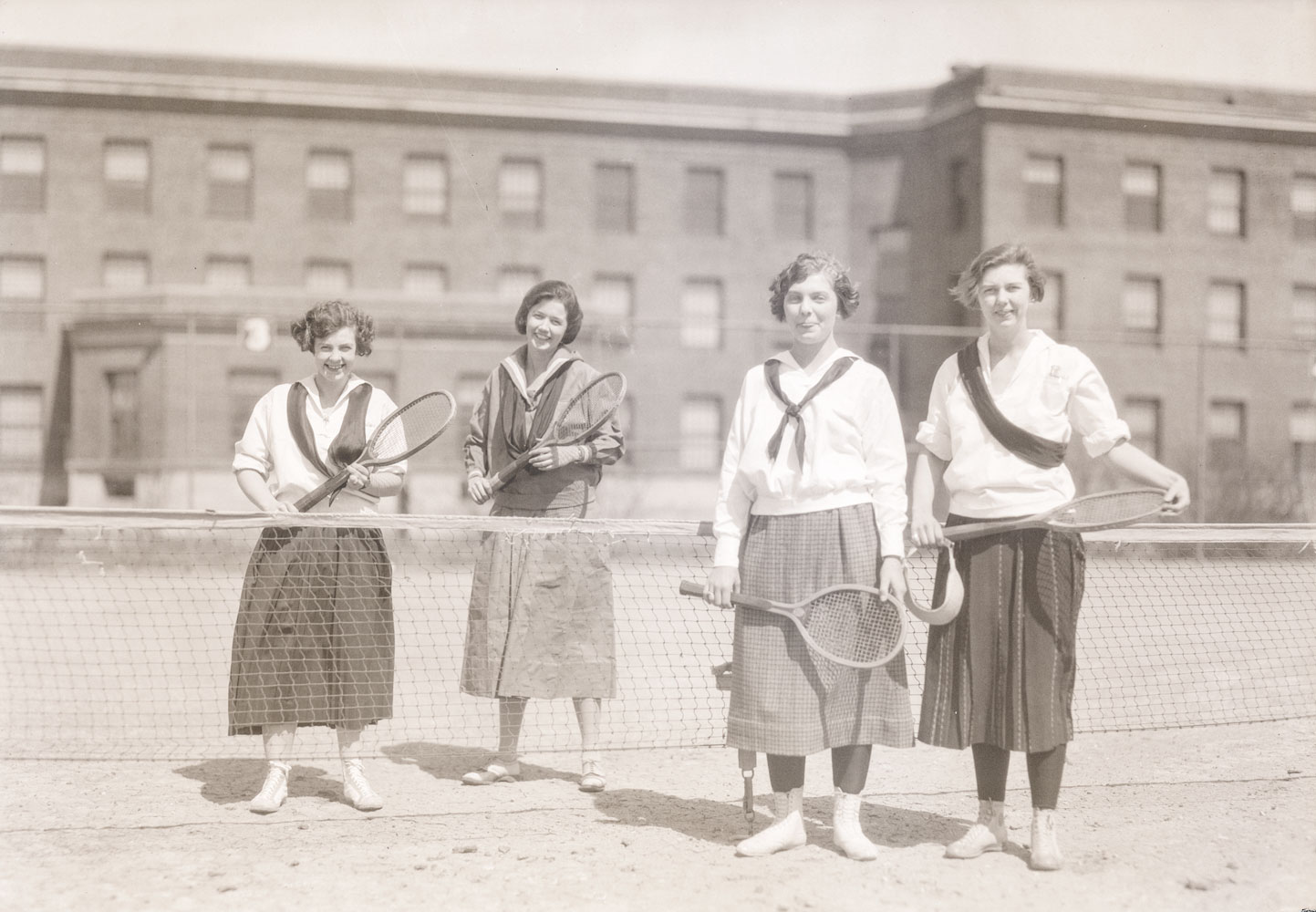
Tennis, 1925

Field hockey, 1952
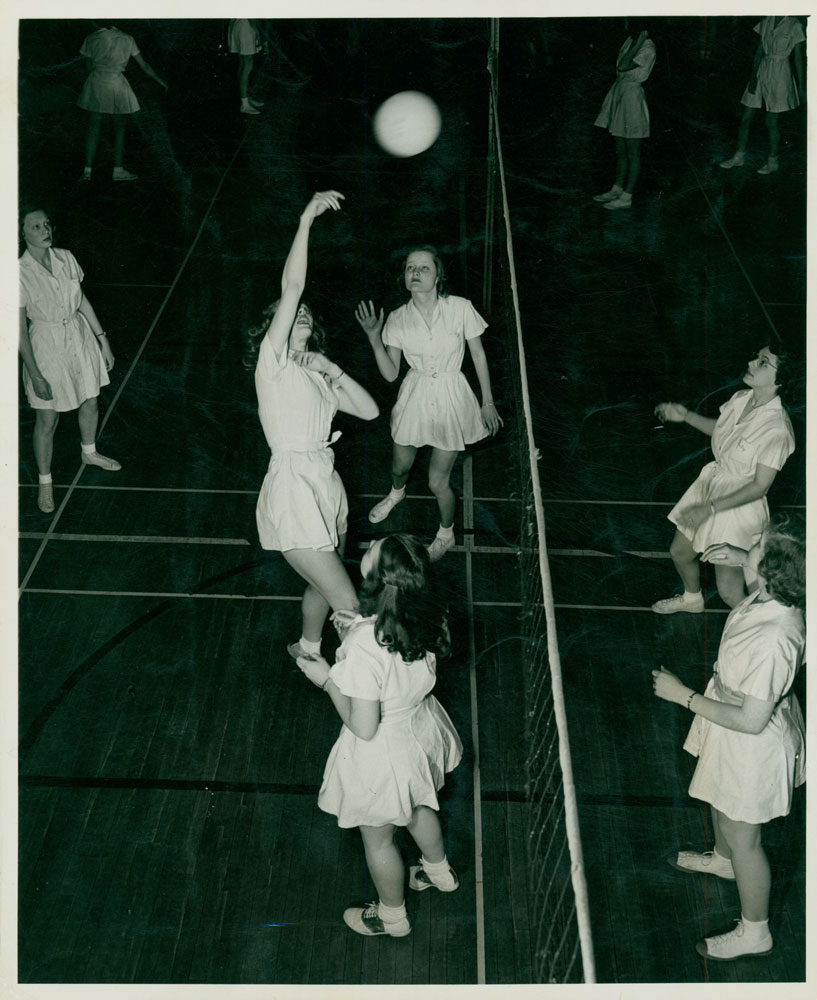
Volleyball, about 1951
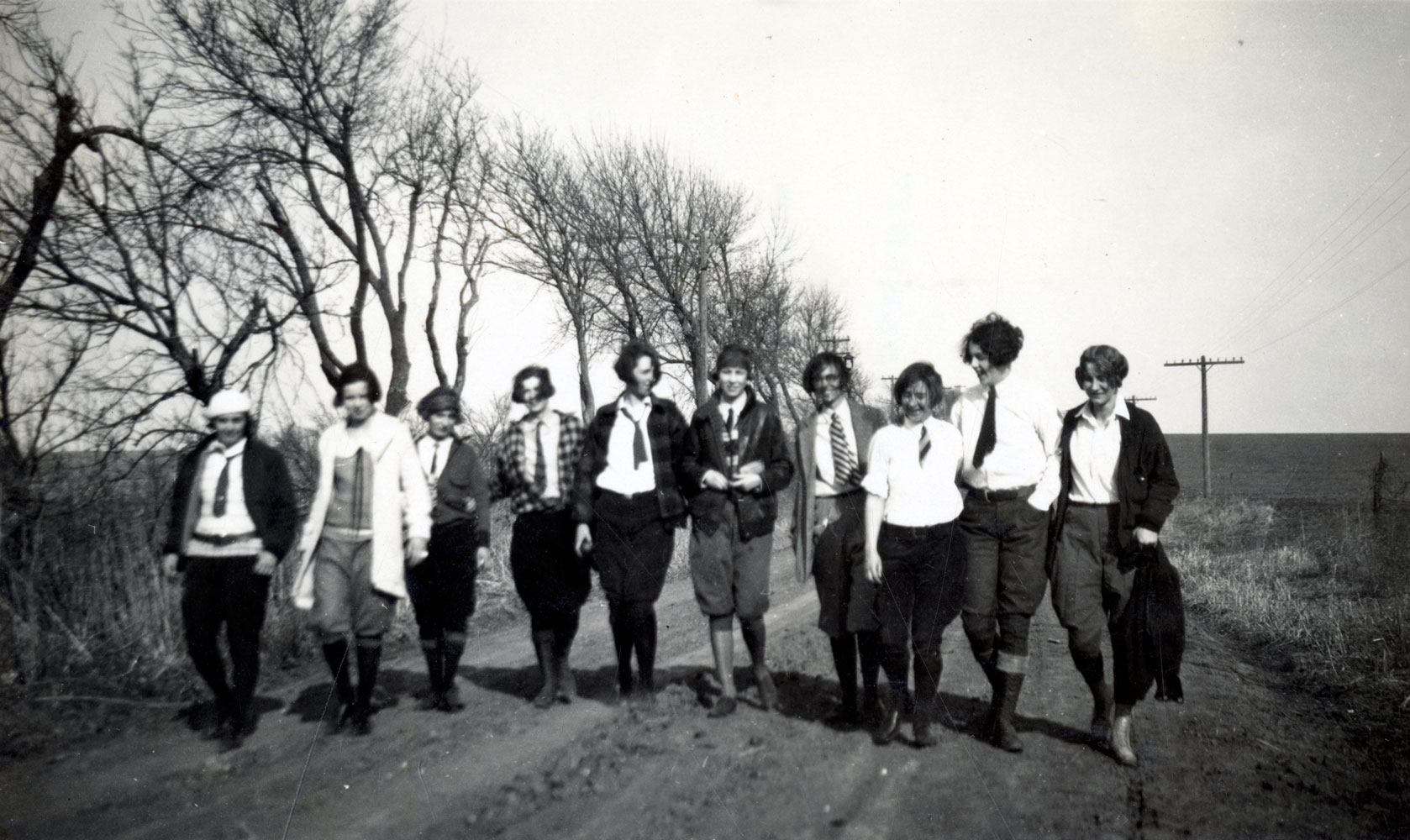
Hiking, 1925
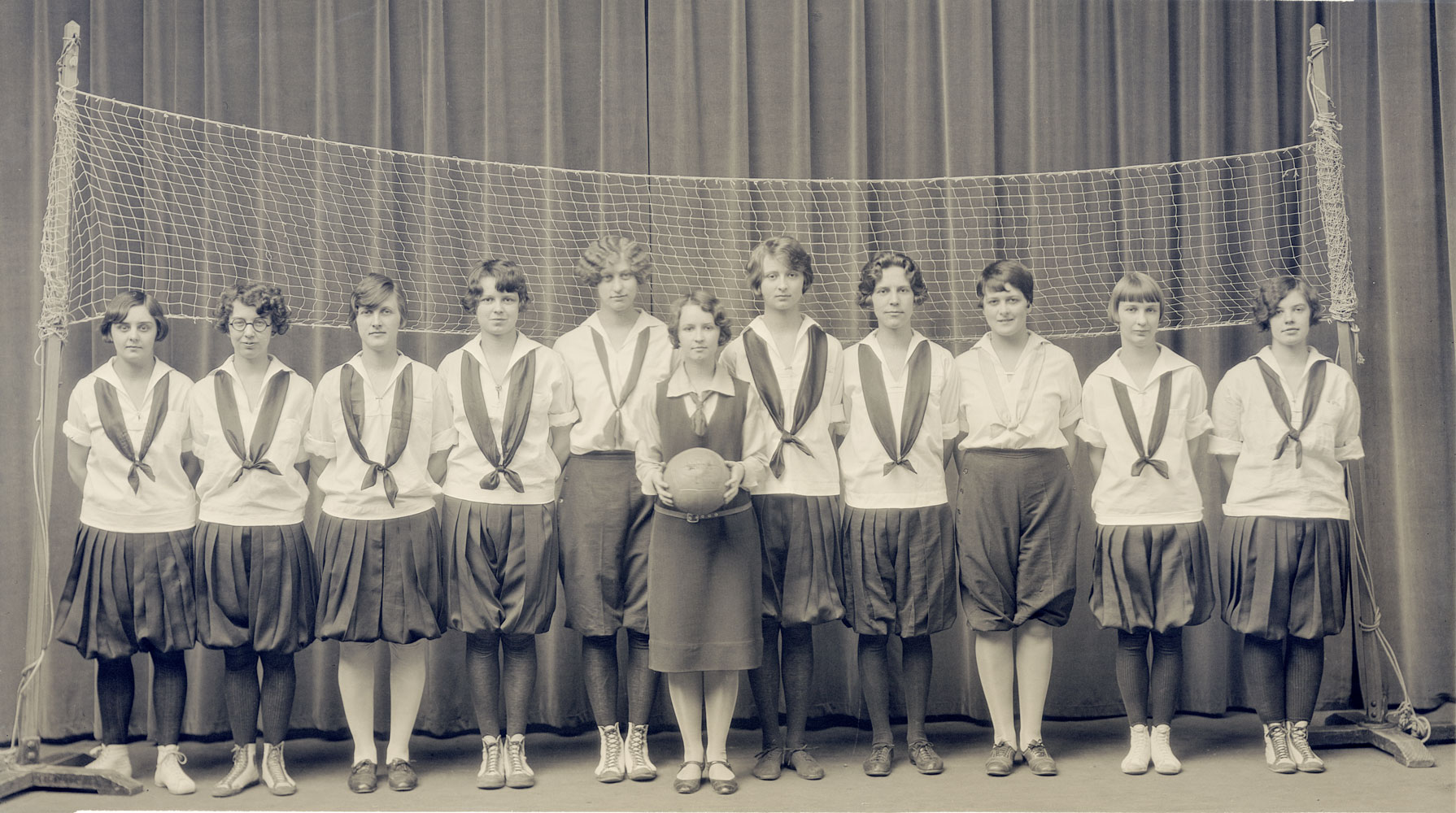
Volleyball, 1927

Bowling, 1951

Basketball, 1958
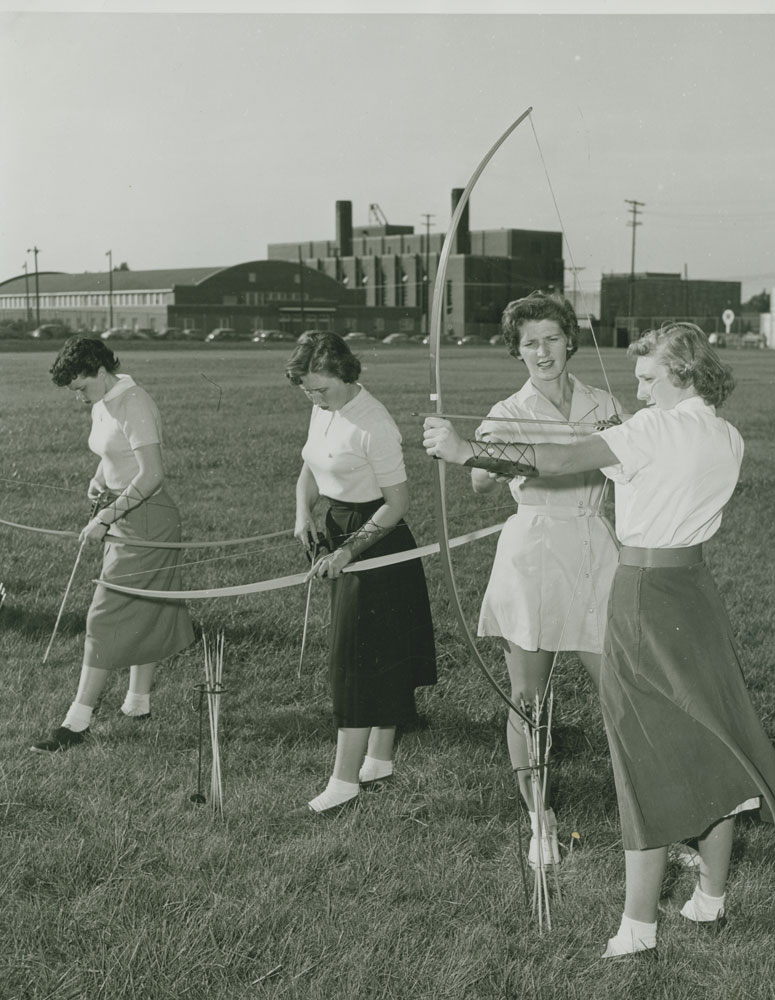
Archery, 1952-1953
Women’s Athletic Association Brochure 1954-1955
The WAA’s brochure emphasizes the fun students will have in its intramural sports and clubs and at the organization’s cabin outside Lincoln.
In addition to women’s intramurals, the WAA sponsored co-rec nights and tournaments, with teams of men and women, in sports like volleyball.


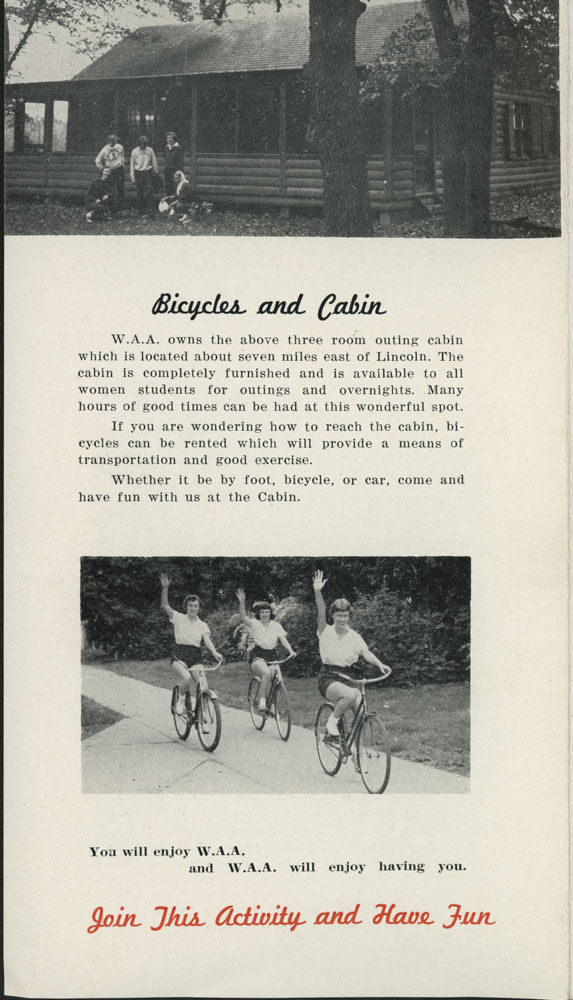
EXTRAMURALS & THE RETURN OF INTERCOLLEGIATE ATHLETICS
WOMEN’S ATHLETIC ASSOCIATION ORGANIZES EXTRAMURAL TEAMS
In 1965 the Women’s Athletic Association developed an extramural sports program to compete against teams from other colleges. WAA board members hoped the program would provide opportunities for “well-skilled girls.”
Top right: Women’s Athletic Association Brochure 1966–1967
During 1967‒1968, the WAA offered gymnastics for the first time. Extramural teams in field hockey, volleyball, swimming, basketball, track, and softball competed against other colleges.
Below: Women’s Athletic Association Brochure 1968–1969
In addition to several intramural sports, the WAA organized extramural volleyball & basketball teams to compete with other colleges.

Bottom Right: WAA Focuses on Intercollegiate Athletics 1971–1975
After the Department of Recreation began overseeing the University’s intramural sports program, the WAA focused on intercollegiate sports. The WAA board and coaches from the Department of Physical Education managed the program’s budget and organized teams and, in 1973, created a handbook for the women’s intercollegiate athletics program.
On August 26, 1975, after administration of women’s intercollegiate athletics had shifted to the Athletic Department, the WAA decided to dispose of its assets and dissolve. The Association disbanded during the 1975–1976 academic year.
A field hockey team played their first extramural match October 30, 1965, after holding six practices. The extramural season included volleyball games with Nebraska Wesleyan and an additional field hockey game held at Doane College in Crete, Nebraska.


Nebraska Women’s Intercollegiate Sports Council (NWISC)
On April 22, 1967, representatives from Nebraska colleges and universities met to discuss setting up a league for women’s intercollegiate sports and formed the Nebraska Women’s Intercollegiate Sports Council.
In the 1969–1970 season the NWISC held its first recognized women’s intercollegiate state tournaments in volleyball, basketball, softball, and swimming.
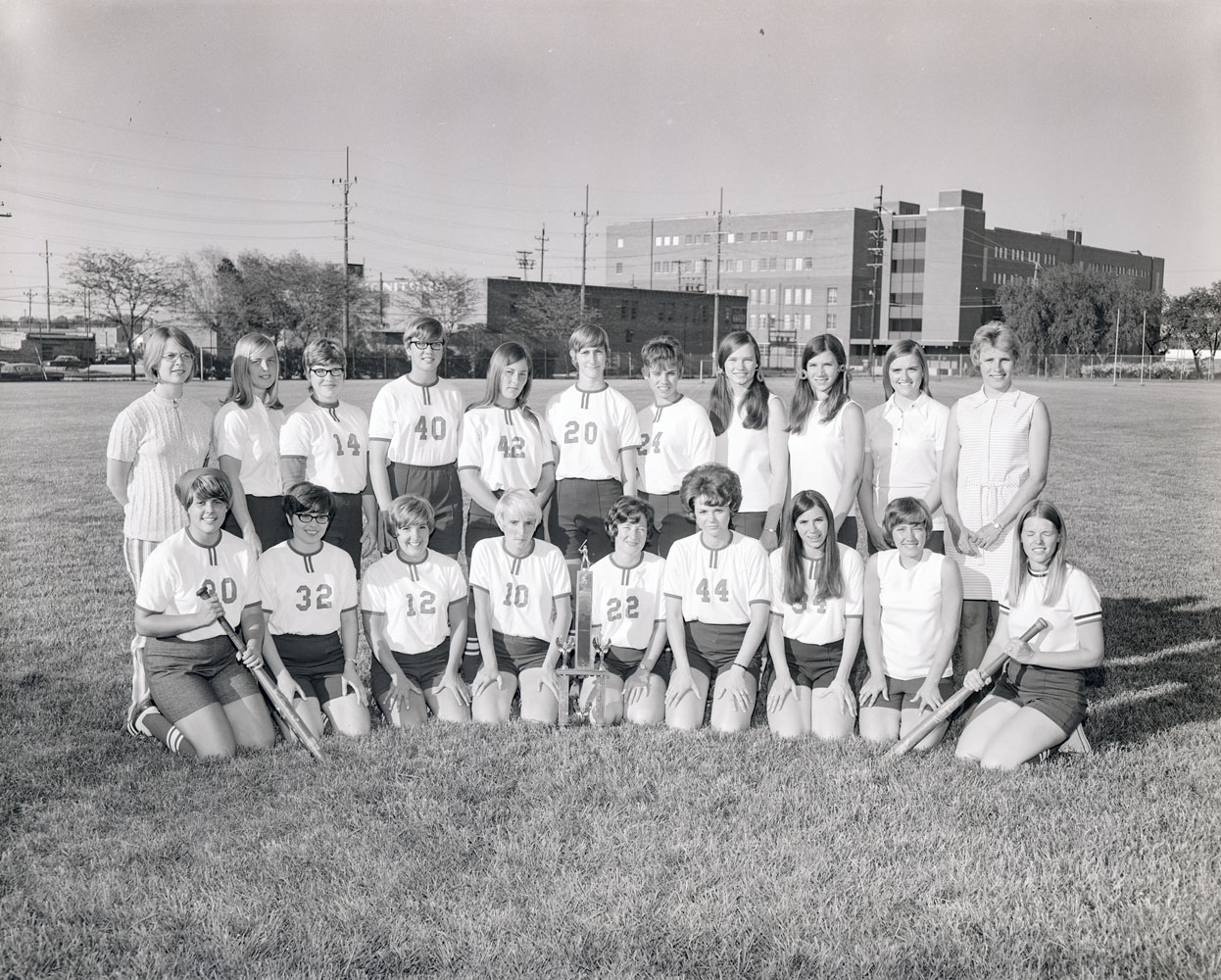
University of Nebraska softball team with state championship trophy, 1971
With a 7–0 record heading in to the NWISC State Softball Tournament, the University of Nebraska team took the title in 1971. They defeated Kearney State 6 to 3 in the championship game.
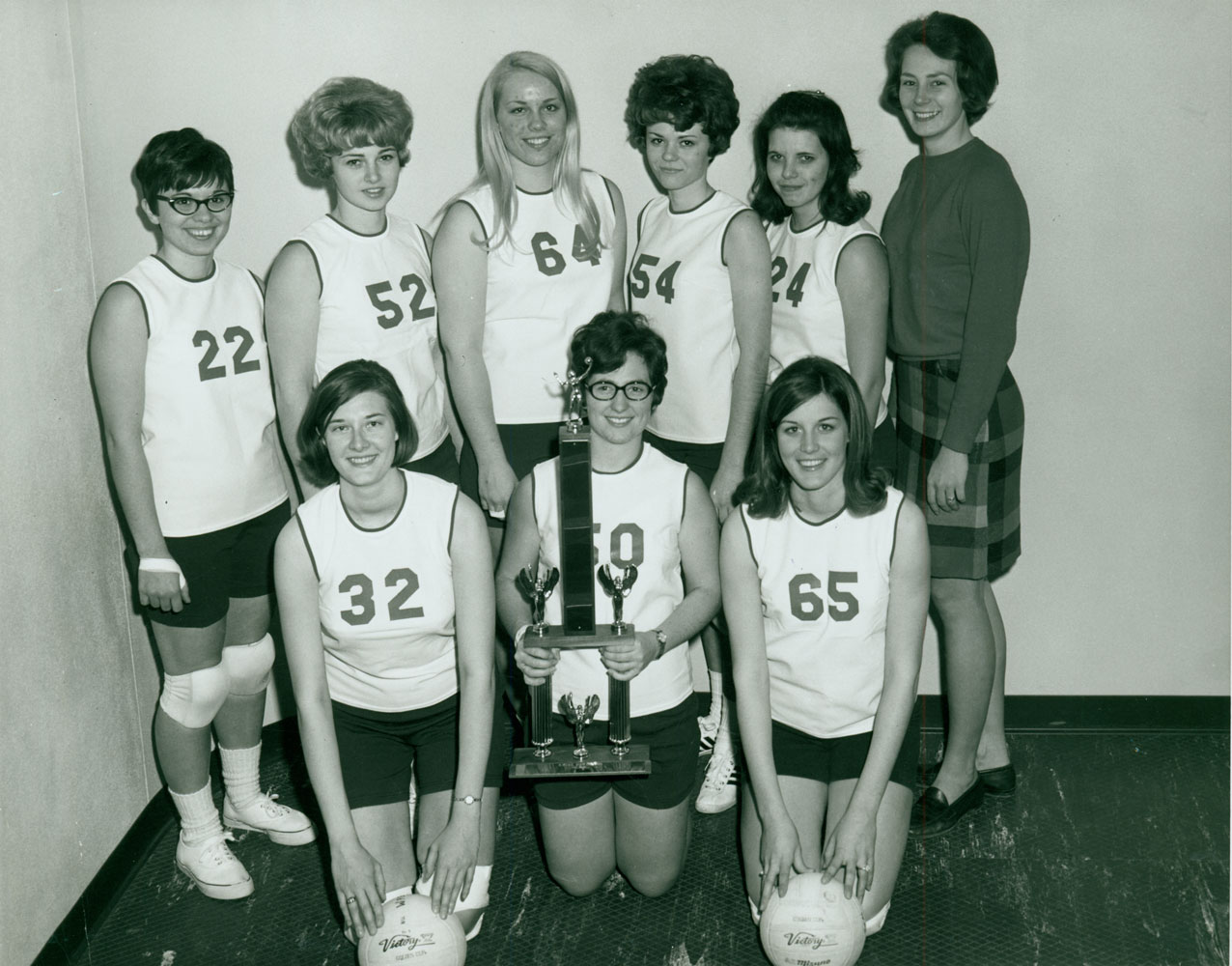
University of Nebraska volleyball team with state championship trophy, 1970
The University of Nebraska won the NWISC State Volleyball Tournament in 1970. Eleven teams competed in the double elimination tournament. Team members (left to right): front row, Kathy Drewes, Kathy Crewdson, Dee Fentimen; back row, Peg Tilgner, Pam Miller, Debbie Knerr, Jan Cheney, Karen Ostrander, and Coach Connie Ludwig. These team members, along with Elise Mahoney and Linda Perry, were invited to the second DGWS National Intercollegiate Volleyball Tournament.
Title IX of the Education Amendments of 1972
Prohibiting Sex Discrimination in Educational Institutions & Programs
On June 23, 1972, President Richard Nixon signed Title IX into law. Title IX prohibits sex-based discrimination and requires education programs or activities receiving federal financial assistance to comply with Title IX regulations. If an educational institution does not comply with the regulations, it may no longer receive federal financial assistance.
Title IX’s application to intercollegiate athletics led to increased funding for women’s varsity teams and athletic scholarships for women.

In addition, as the University moved toward compliance, the Athletic Department took on general supervision of women’s athletics in 1974 and designated Gail Whitaker as Assistant Athletic Director. In July 1975 the University hired Aleen Swofford as the first full-time Women’s Athletic Director. After nearly seventy years, women’s athletics were once again part of the Athletic Department.
“No person in the United States shall, on the basis of sex, be excluded from the participation in, be denied the benefits of, or be subjected to discrimination under any education program or activity receiving Federal financial assistance . . .”
FUNDING FOR WOMEN’S TEAMS INCREASES
When the WAA contract for concessions ended in 1947, the Athletic Department agreed to provide the WAA $1,500 each year in place of the concession revenue. This yearly payment formed the core of the women’s intercollegiate athletics budget in the early 1970s.
Physical Education faculty members coached the women’s teams, and the department provided facilities and some equipment. The responsibility strained the department’s resources. The budget was too tight to cover many basics like athletic shoes, warmup uniforms, publicity, coaches’ salaries, and travel costs.
During a WAA board meeting in May 1973, members even considered holding a bake sell at the local shopping mall to raise funds for women’s teams.
“Although other Big Eight Schools are showing interest in league competition, Nebraska simply doesn’t have the money to support her athletic teams in intercollegiate competition.”


Women’s Intercollegiate Athletic Budget Increases following Title IX
In 1975 Title IX federal regulations for athletics were issued and schools were required to comply within three years. The Report of the Chancellor’s Title IX Review Committee on Athletics presented to Chancellor Roy A. Young, December 5, 1979, shows increased funding for women’s athletics as the University worked toward compliance.
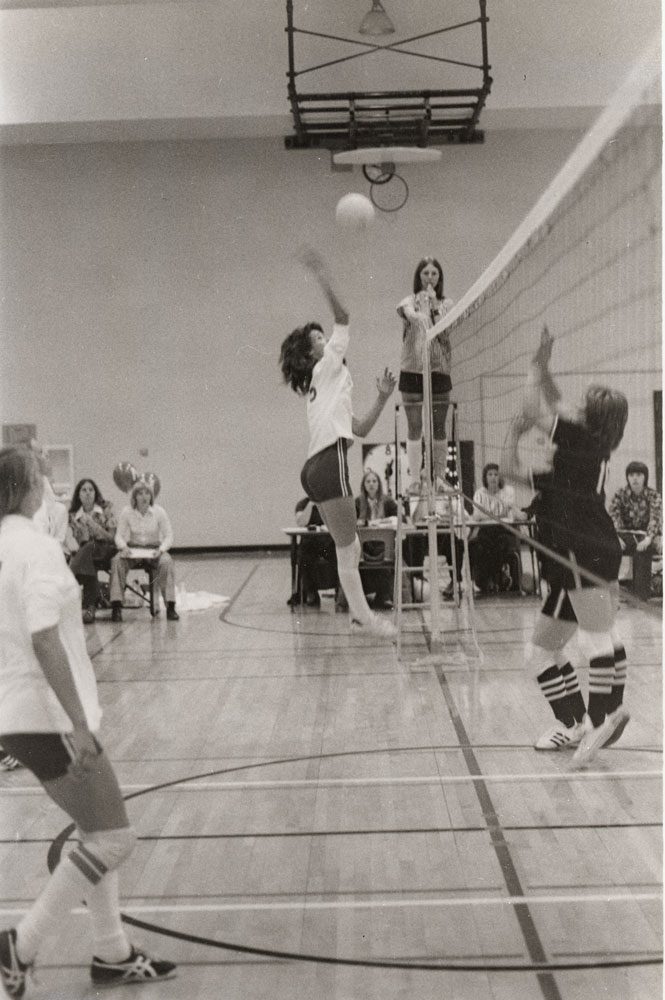
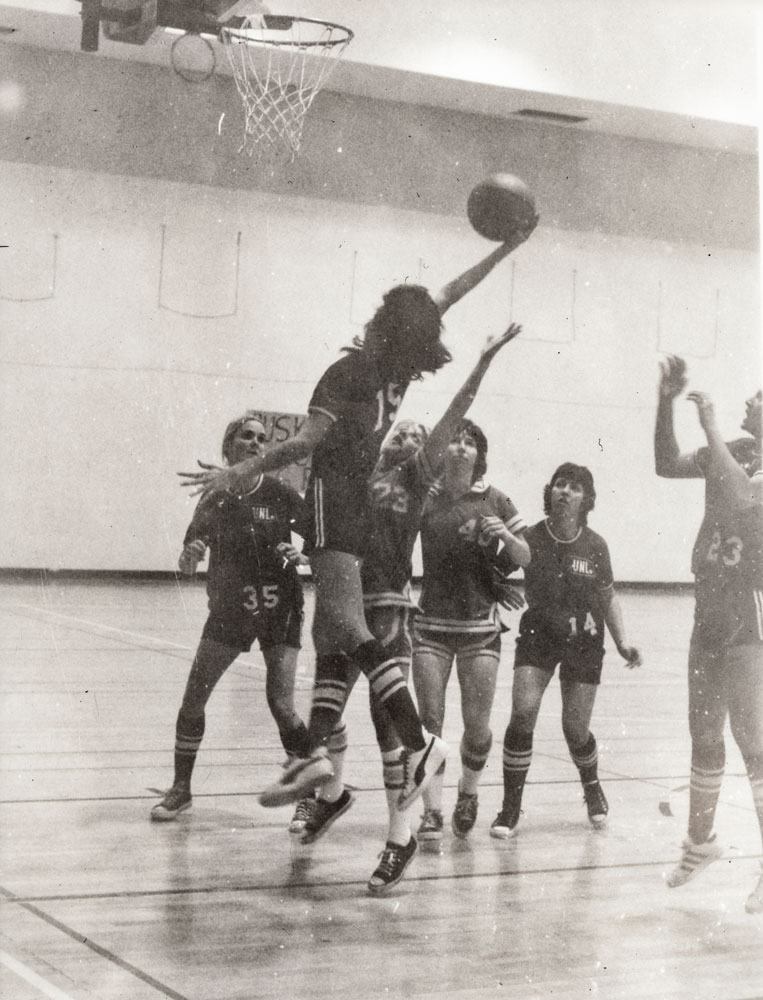
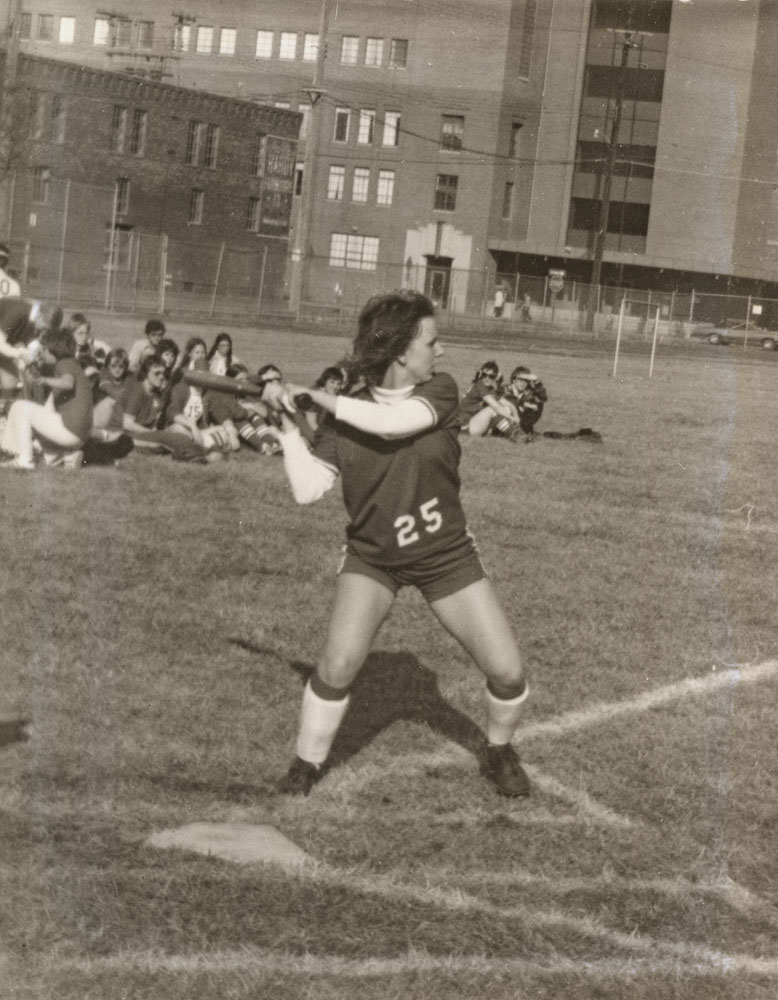
ATHLETIC SCHOLARSHIPS FOR WOMEN
The University of Nebraska did not award athletic scholarships to women until after Title IX. National and local organizations overseeing women’s athletics opposed women’s athletic scholarships. Leaders believed athletic scholarships professionalized college sports and overemphasized student athletes’ identity as athletes rather than students.

A letter from the Chair of the NWISC, May 1, 1972, explains John F. Kennedy College’s softball team is barred from the Nebraska state softball tournament and Women’s College World Series because the college awards athletic sholarships to women.
NWISC Prohibits Women’s Athletic Scholarships & Recruitment
On April 23, 1972, the Nebraska Women’s Intercollegiate Sports Council (NWISC) passed a motion barring membership to colleges and universities that awarded athletic scholarships to women or recruited women to play sports. Schools with these practices were also prohibited from playing in NWISC state tournaments. The ban on scholarships and recruiting reflected standards set by the Division of Girls and Women’s Sports (DGWS) of the American Alliance for Health, Physical Education, and Recreation and the Association for Intercollegiate Athletics for Women (AIAW).
AIAW Ban on Women’s Athletic Scholarship Ends
In January 1973 plaintiffs from Marymount College and Broward Community College in Florida filed a lawsuit challenging the AIAW ban on women’s athletic scholarships. Part of the plaintiffs’ argument relied on Title IX’s prohibition discrimination on the basis of sex. Responding to the lawsuit, the AIAW changed its policy but not its philosophy. Announcing the end of the women’s athletic scholarship ban, the association clarified their position: “We wish it to be understood that this practice is not recommended but it is now permitted.”
Women’s Athletic Scholarships at the University of Nebraska
The University of Nebraska first awarded women’s athletic scholarships in 1975. In a Title IX Self-Evaluation dated March 24, 1975, the Athletic Department reported 164 men received full athletic scholarships, and 86 received partial athletic scholarships with a total $539,000 awarded to men. No women received full athletic scholarships, while 56 received partial scholarships. In total, women’s athletic scholarships amounted to $37,448.
In a University-wide Title IX Self-Evaluation from 1976, the self-evaluation committee acknowledged the gap in scholarship awards and recommended women athletes receive roughly proportional awards. The Chancellor’s Title IX Review Committee on Athletics reported women were awarded 26 full athletic scholarships and 36 partial scholarships for the 1979-1980 academic year.
TITLE IX’S LEGACY
After Title IX, the University of Nebraska women’s intercollegiate athletic program expanded, with increased funding and institutional support. However, the shift toward equitable opportunity for women athletes was neither instantaneous nor total. More than a century after women at the University of Nebraska petitioned for equitable physical training, collegiate athletes press on toward equitable opportunities.
Terminology & Bibliography
Extramural – sports played with opponents from outside campus
Intramural – sports played by opponents who are members of the student body
Intercollegiate – sports played with opponents from other colleges
Interclass – sports played by teams from different classes, for example “the class of 1902 vs. the class of 1903”
Board of Intercollegiate Athletics, RG 39-04-00. Archives & Special Collections, University of Nebraska-Lincoln Libraries.
Centralized Academic Files, Chancellor Records, RG-05-01-01. Archives & Special Collections, University of Nebraska-Lincoln Libraries.
Congress of the U.S., Washington, D.C. Senate Committee on Labor and Public Welfare. Prohibition of Sex Discrimination., 1975.
Hearings Before the Subcommittee on Education of the Committee on Labor and Public Welfare on S. 2106 to Amend Title IX of the Education Amendments of 1972. United States Senate, Ninety-Fourth Congress, First Session, 1975.
Correspondence, Women’s Athletics Records, RG-39-20-04. Archives & Special Collections, University of Nebraska-Lincoln Libraries.
Durward B. Varner, Correspondence, President Records, RG-02-03-01. Archives & Special Collections, University of Nebraska-Lincoln Libraries.
Edwards, A. “Why Sport? The Development of Sport as a Policy Issue in Title IX of the Education Amendments of 1972.” Journal of Policy History, 22:3, 300-336, 2010.
Faculty, Physical Education for Women Records, RG-23-18-02. Archives & Special Collections, University of Nebraska-Lincoln Libraries.
Hoepner, Barbara J., Ed. Women’s Athletics: Coping with Controversy. American Association for Health, Physical Education, and Recreation Division for Girls’ and Women’s Sports, 1974.
Husker Happenings, Women’s Athletics Records, RG-39-20-01. Archives & Special Collections, University of Nebraska-Lincoln Libraries.
James H. Zumberge, Outgoing Correspondence, Chancellor Records. Archives & Special Collections, University of Nebraska-Lincoln Libraries.
Lee, Mabel. “The Case For and Against Intercollegiate Athletics for Women and the Situation Since 1923.” The Research Quarterly of the American Physical Education Society, 2:2, 93-127, 1931.
Lee, Mabel. The Conduct of Physical Education; Its Organization and Administration for Girls and Women. A. S. Barnes and Company, 1937.
Lee, Mabel. Memories Beyond Bloomers, 1924-1954. American Alliance for Health, Physical Education, and Recreation, 1978.
Lee, Mabel. Memories of a Bloomer Girl, 1894-1924. American Alliance for Health, Physical Education, and Recreation, 1977.
Memoirs and Theses, Physical Education for Women Records, RG-23-18-07. Archives & Special Collections, University of Nebraska-Lincoln Libraries.
Miller, Jana. “Women’s Athletics On Move – Director.” The Lincoln Star, 3 August 1975. p. 2C.
Minutes and Agendas, Board of Regents Records, RG-01-01-02. Archives & Special Collections, University of Nebraska-Lincoln Libraries.
Nebraska Women’s Intercollegiate Sports Council (NWISC), Women’s Athletics Records, RG-39-20-03. Archives & Special Collections, University of Nebraska-Lincoln Libraries.
Newsletter, Physical Education for Women Records, RG-23-18-05. Archives & Special Collections, University of Nebraska-Lincoln Libraries.
Photographs and Slides, Physical Education for Women Records, RG-23-18-11. Archives & Special Collections, University of Nebraska-Lincoln Libraries.
“Policies on Women Athletes Change.” Journal of Health, Physical Education, Recreation, 44:7, 51-54, 1973. Region VI, Association of Intercollegiate Athletics for Women (AIAW), Women’s Athletics Records, RG-39-20-02. Archives & Special Collections, University of Nebraska-Lincoln Libraries.
Reports and General Files, Board of Regents Records, RG-01-01-01. Archives & Special Collections, University of Nebraska-Lincoln Libraries.
Robert D. Scott, English Papers, RG-12-10-10. Archives & Special Collections, University of Nebraska-Lincoln Libraries.
Samuel Avery, Correspondence, Chancellor Records, RG-05-10-01. Archives & Special Collections, University of Nebraska-Lincoln Libraries.
Samuel Avery, University Correspondence, Chancellor Records, RG-05-10-03. Archives & Special Collections, University of Nebraska-Lincoln Libraries.
Samuel Avery, Subject Correspondence, Chancellor Records, RG-05-10-04. Archives & Special Collections, University of Nebraska-Lincoln Libraries.
Samuels, Jocelyn and Galles, Kristen. “In Defense of Title IX: Why Current Policies Are Required to Ensure Equality of Opportunity.” 14 Marquette Sports Law Review 11, 2003.
Scrapbooks, Physical Education for Women Records, RG-23-18-09. Archives & Special Collections, University of Nebraska-Lincoln Libraries.
Staurowsky, Ellen J. “A Radical Proposal: Title IX Has No Place in College Sport Pay-For-Play Discussions.” 22 Marquette Sports Law Review 575, 2012.
Stewart, Pamela. “Creating Staunch Hearted, Bright-Eyed Sportswomen: The Montana Legacy of Athlete and Educator Ina E. Gittings.” Montana: The Magazine of Western History 66, no. 1: 3–17, 2016.
Subject Files, Physical Education for Women Records, RG-23-18-03. Archives & Special Collections, University of Nebraska-Lincoln Libraries.
Title IX Coordinator, Chancellor Records, RG-05-00-01. Archives & Special Collections, University of Nebraska-Lincoln Libraries.
University Photos, University Communications Records, RG-42-12-02 and RG-42-12-03. Archives & Special Collections, University of Nebraska-Lincoln Libraries.
Verbrugge, Martha H. Active Bodies: A History of Women’s Physical Education in Twentieth-Century America. Oxford University Press, 2012.
Ware, Susan. Game, Set, Match Billie Jean King and the Revolution in Women’s Sports. University of North Carolina Press, 2011.
Women’s Athletic Association, Physical Education for Women Records, RG-23-18-13. Archives & Special Collections, University of Nebraska-Lincoln Libraries.

